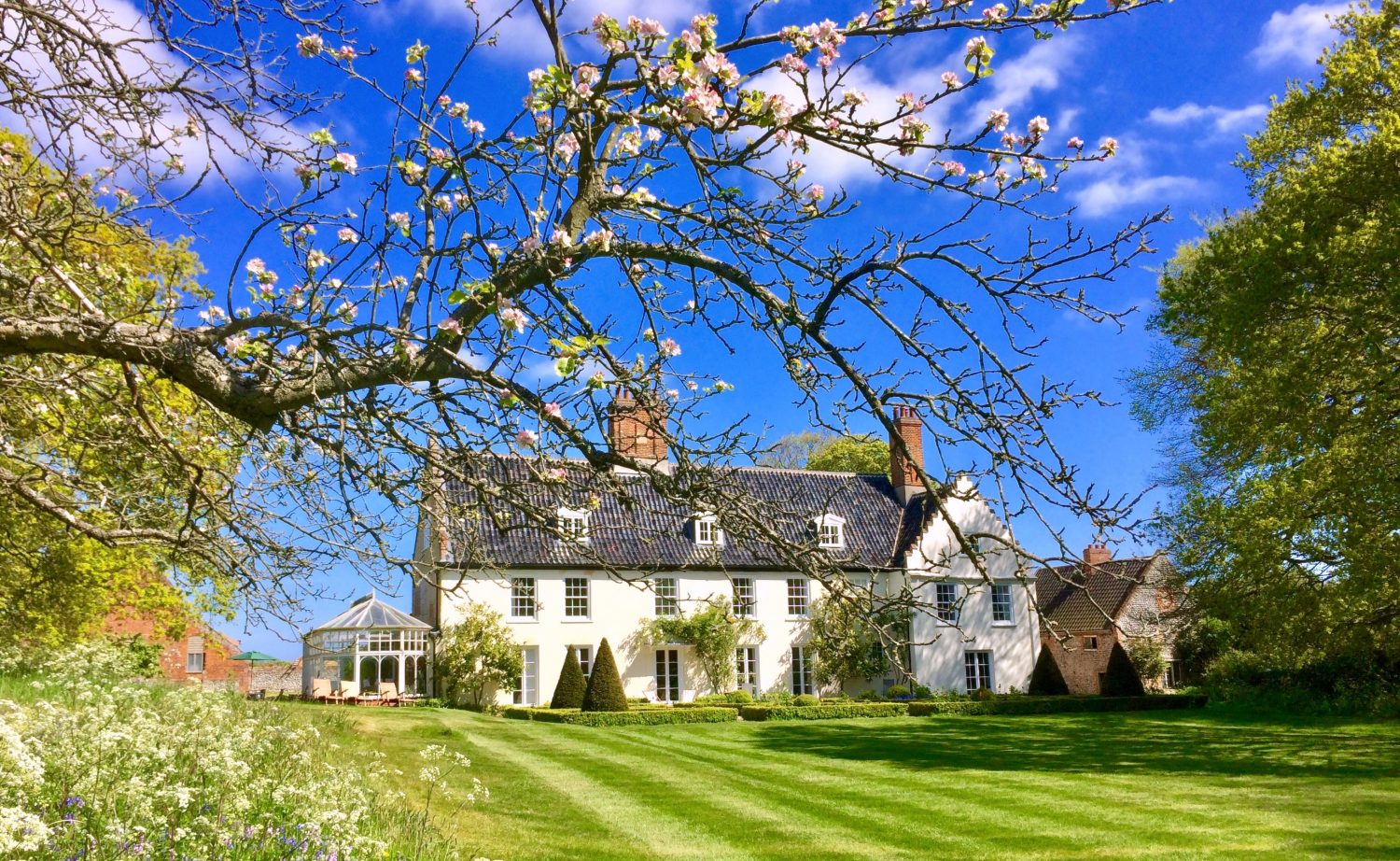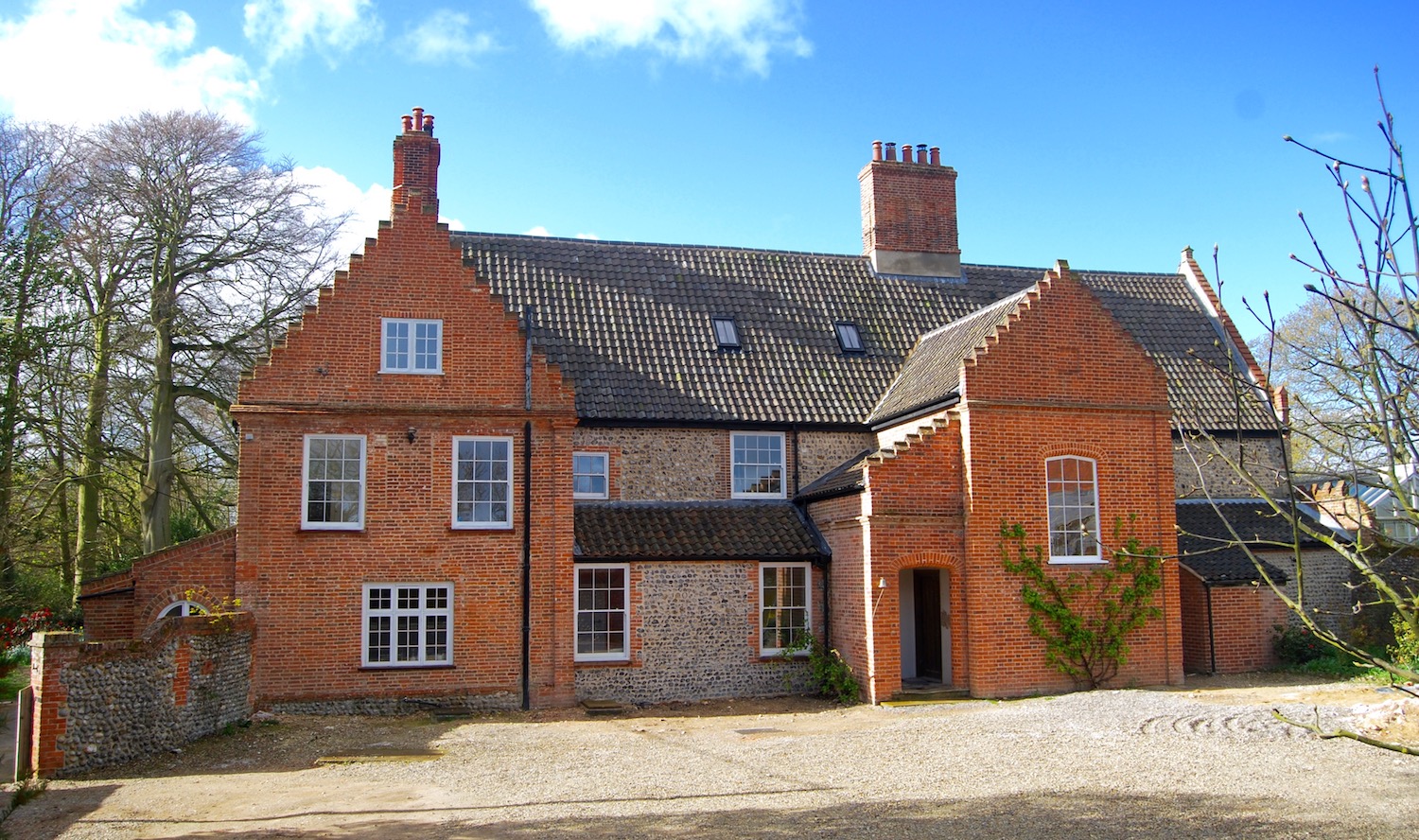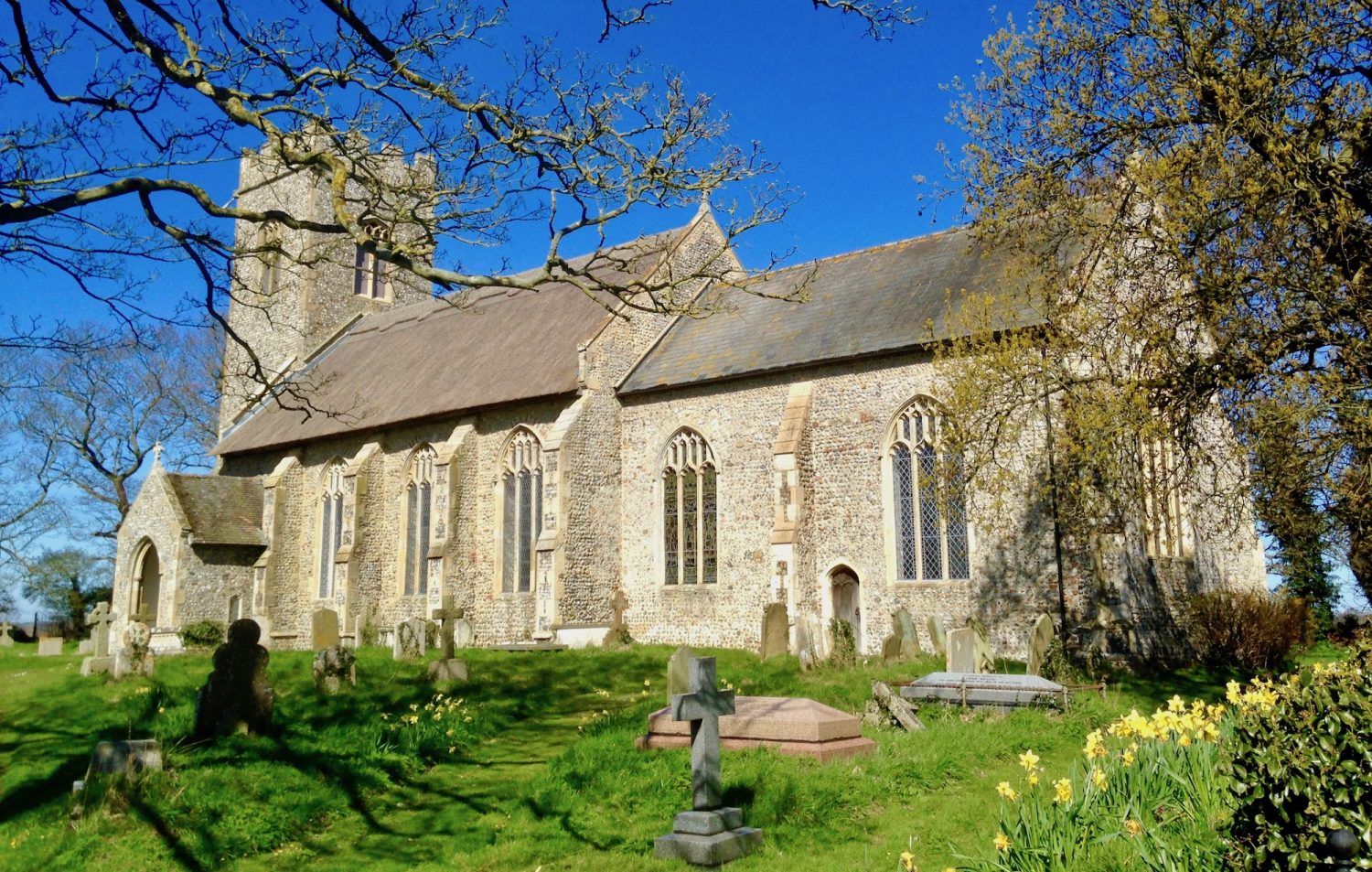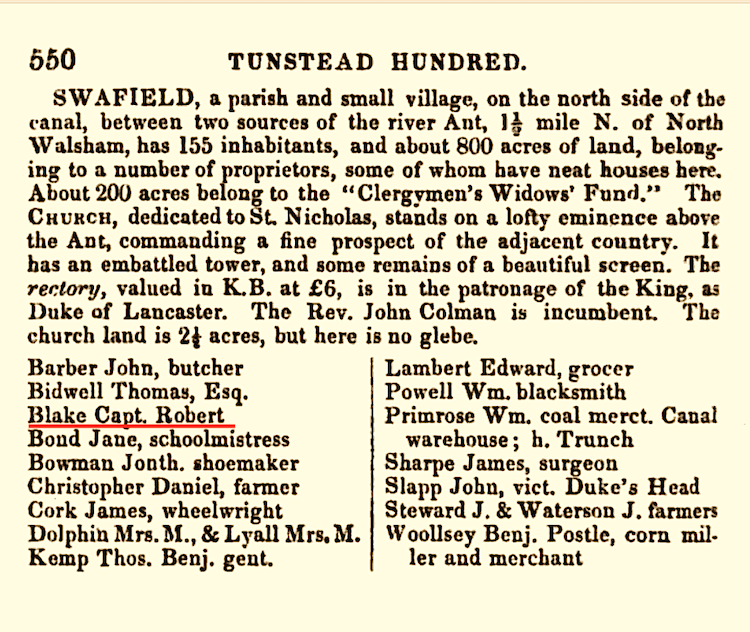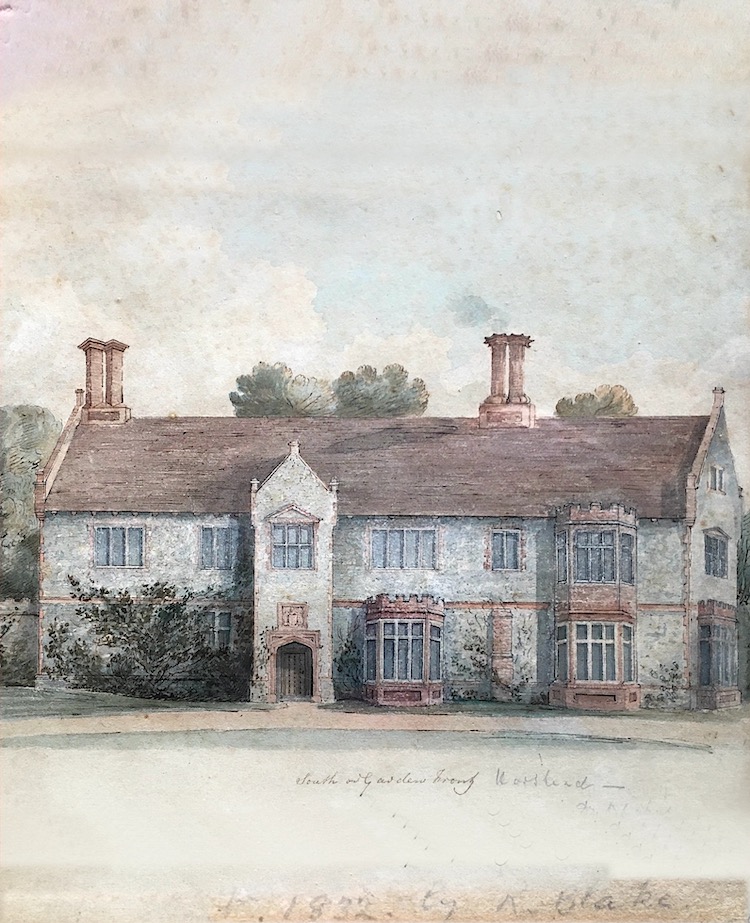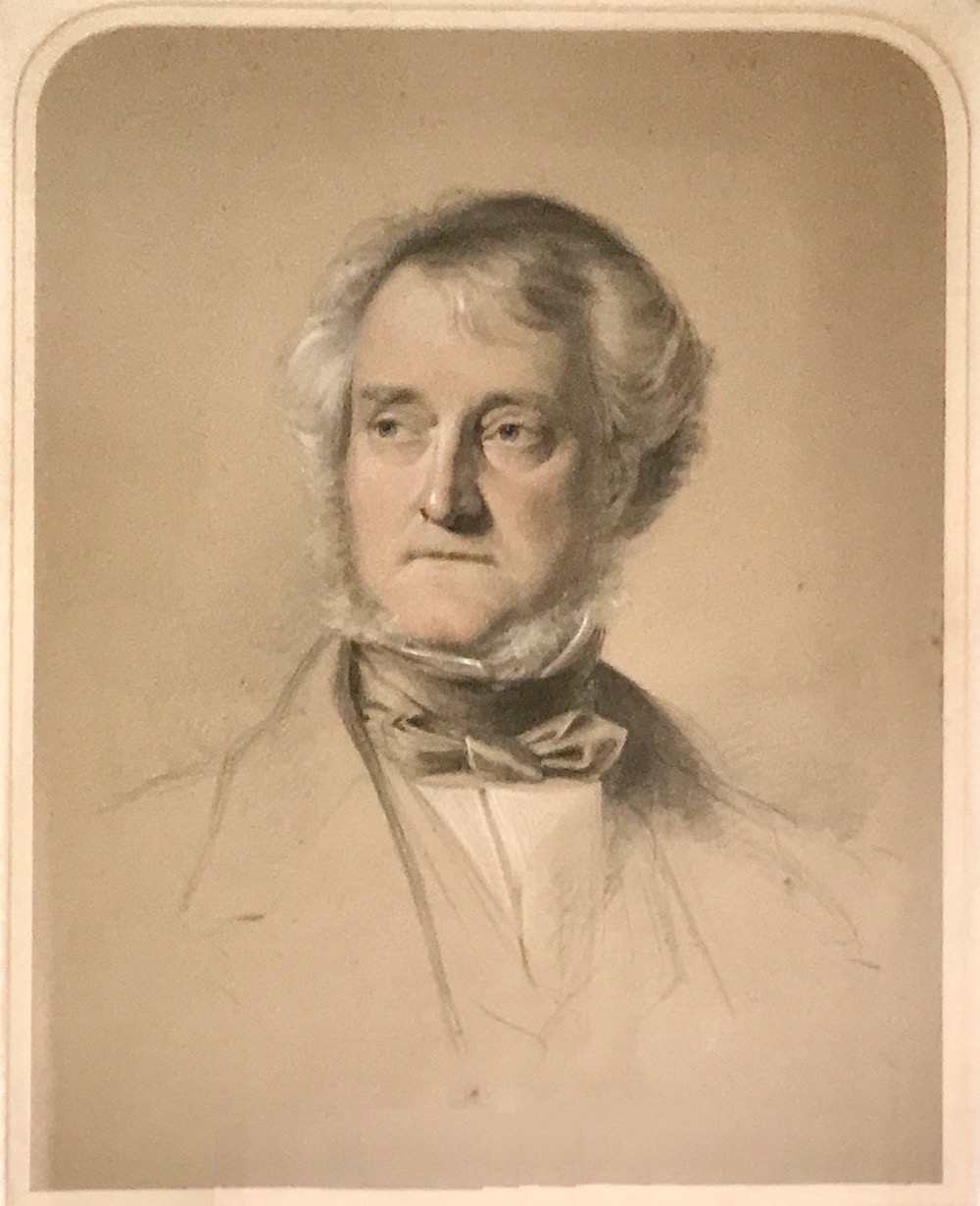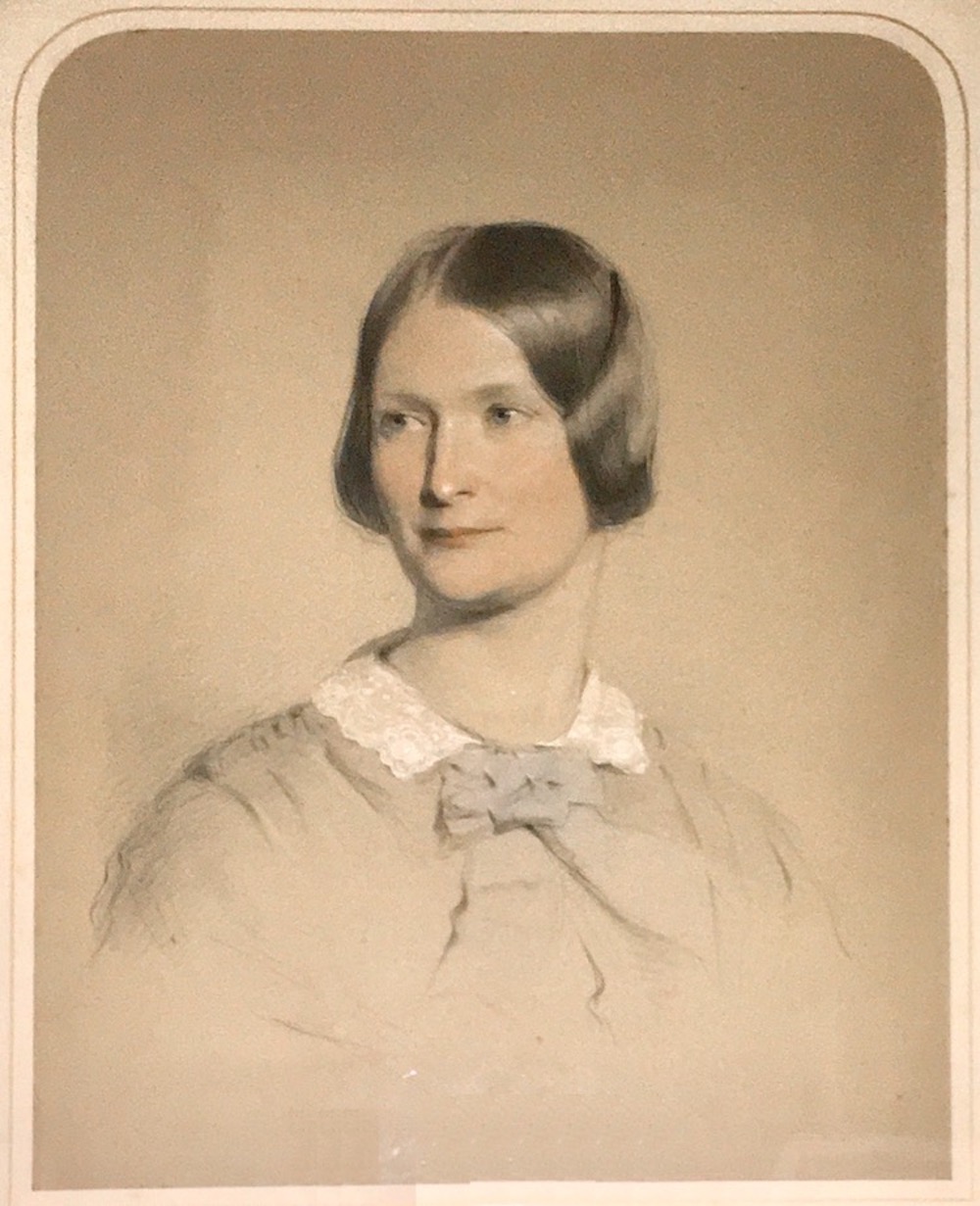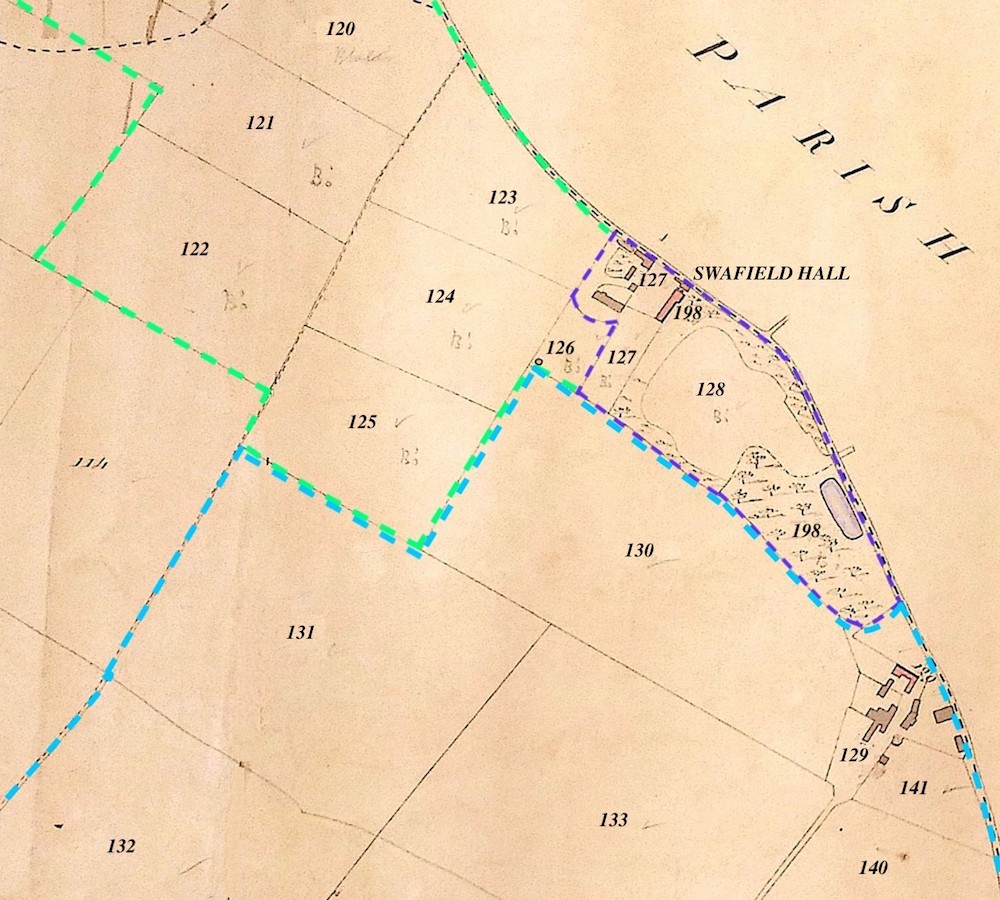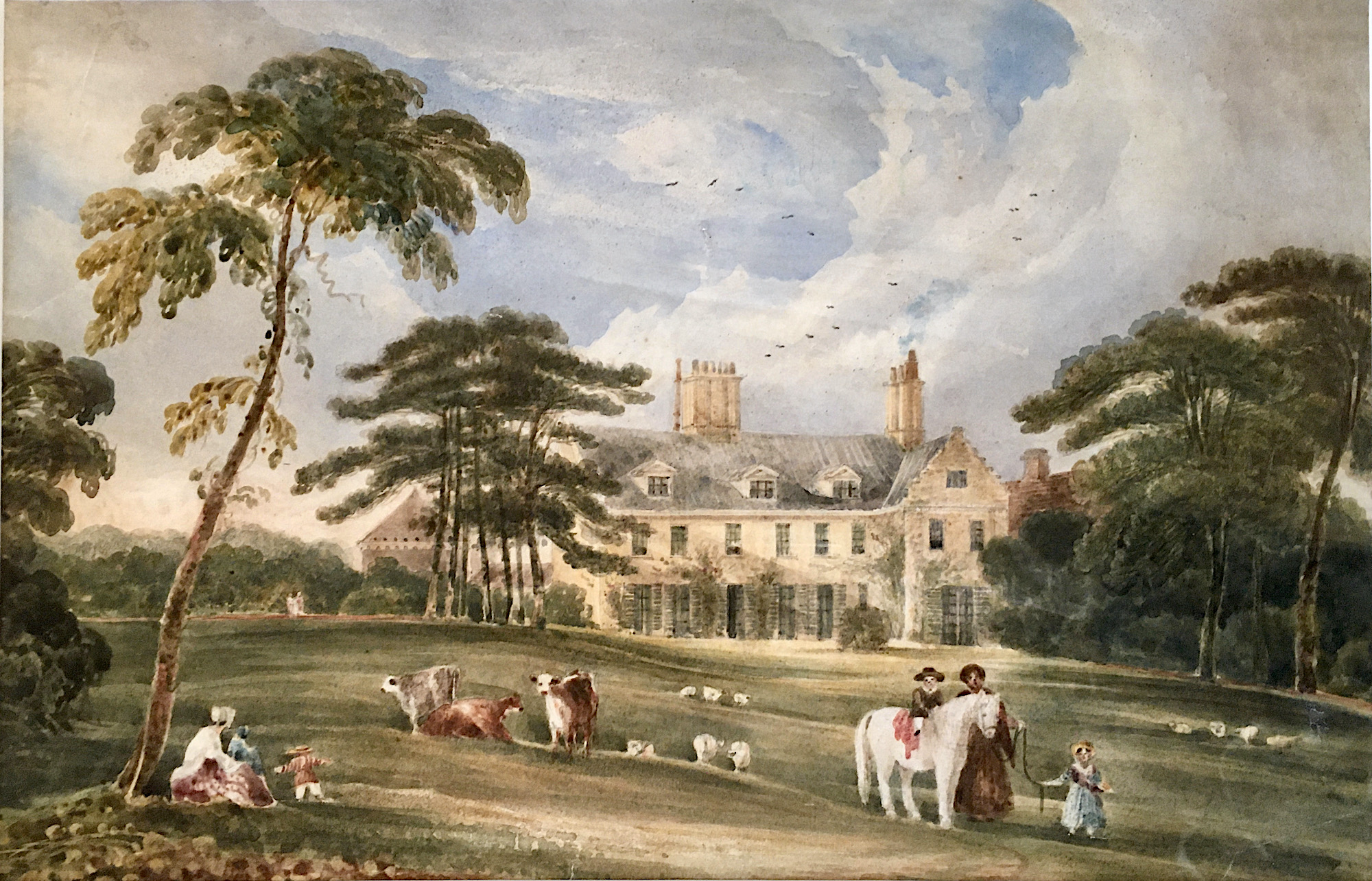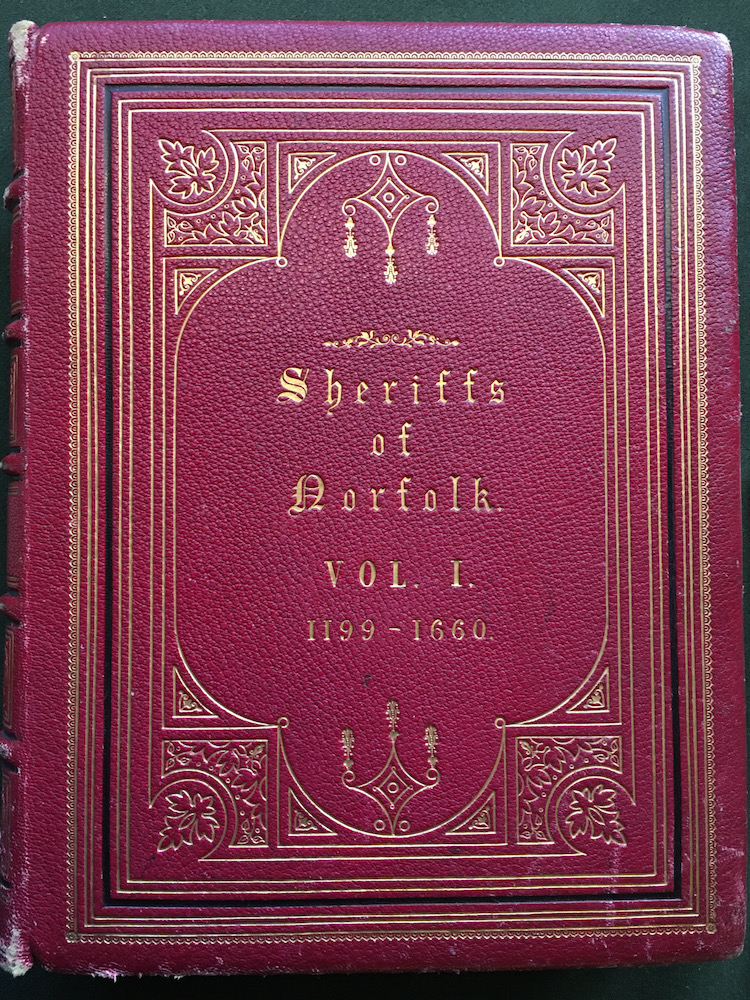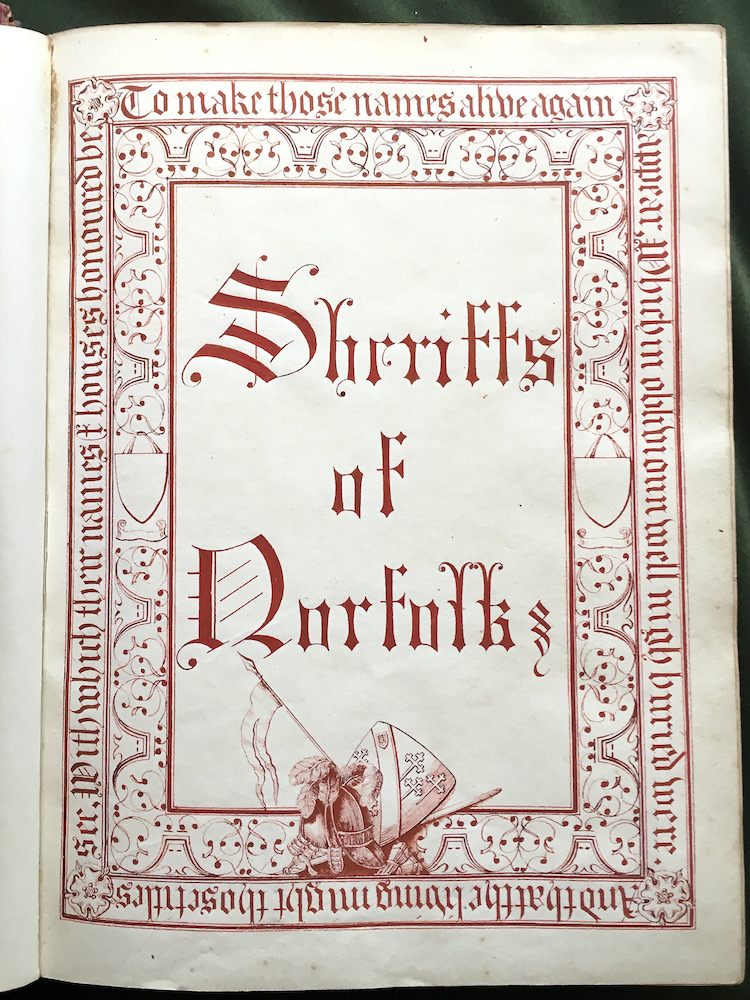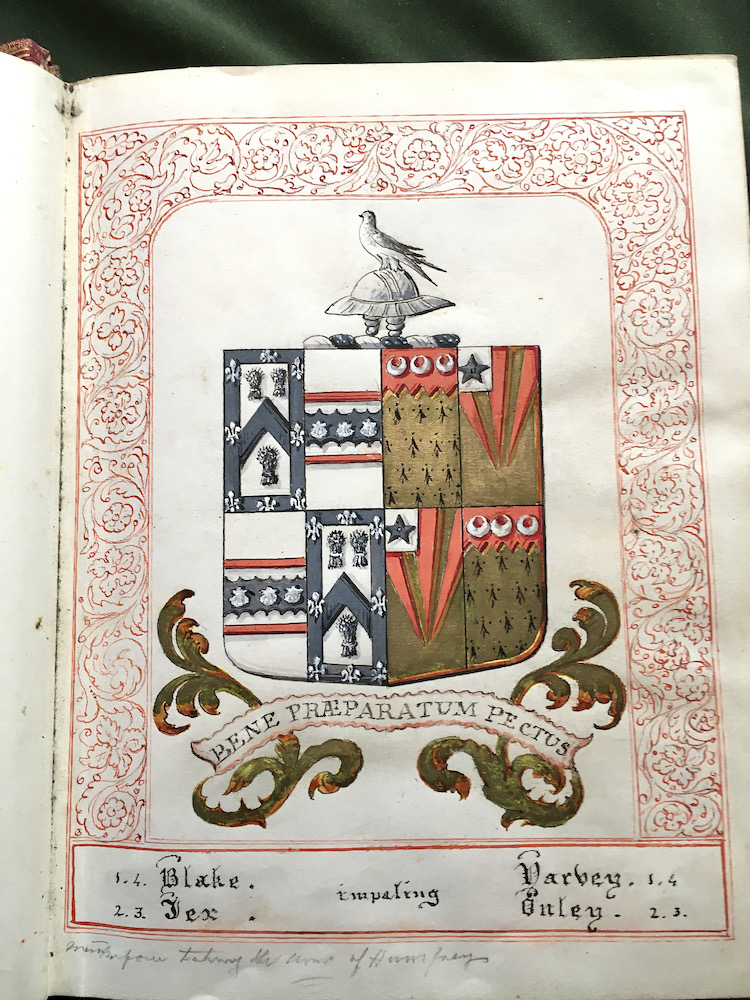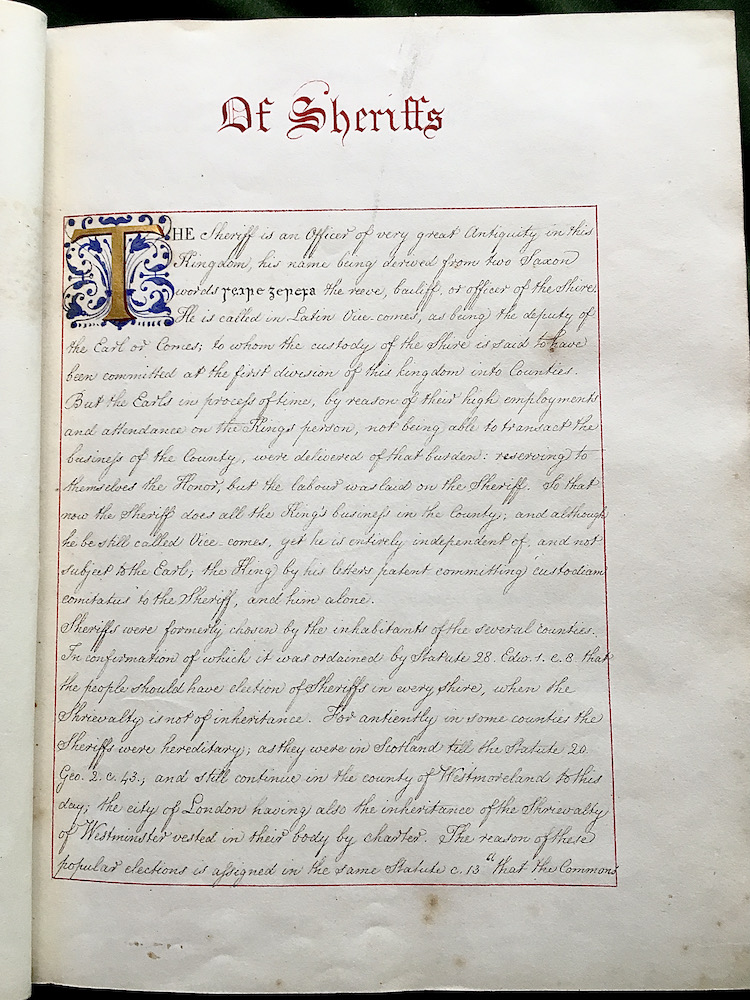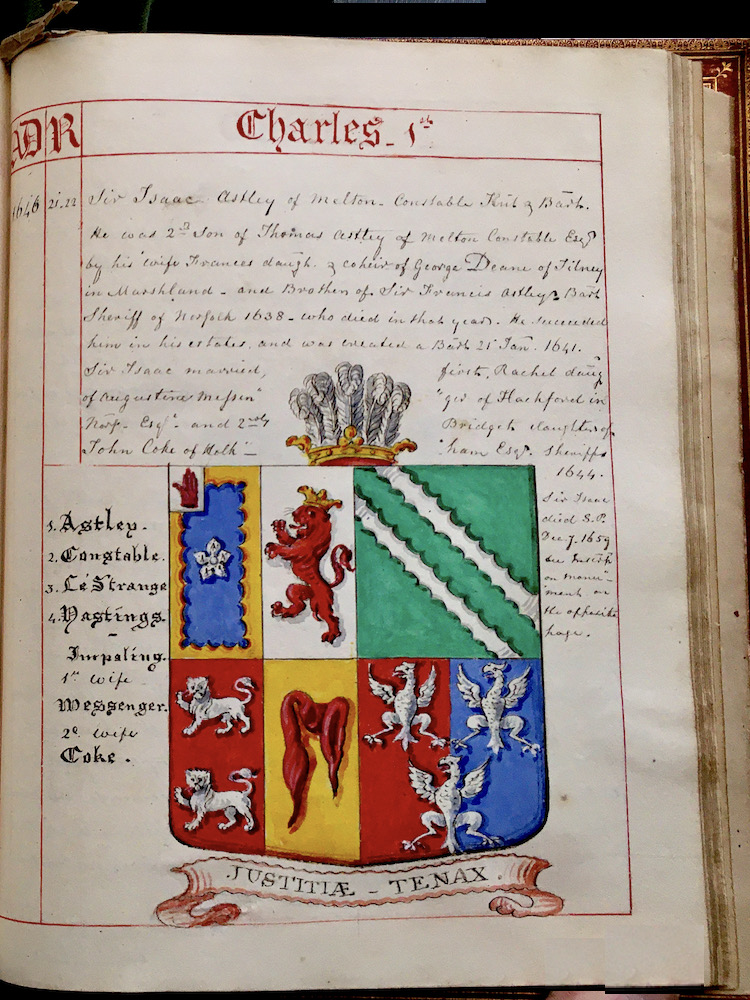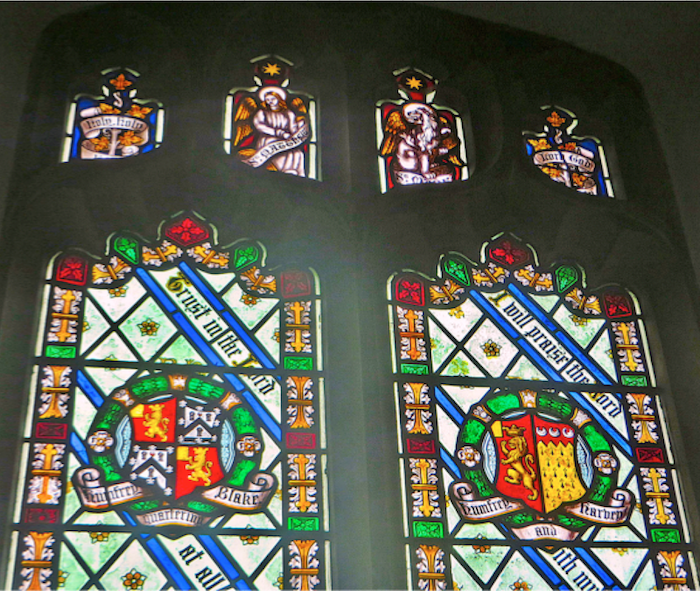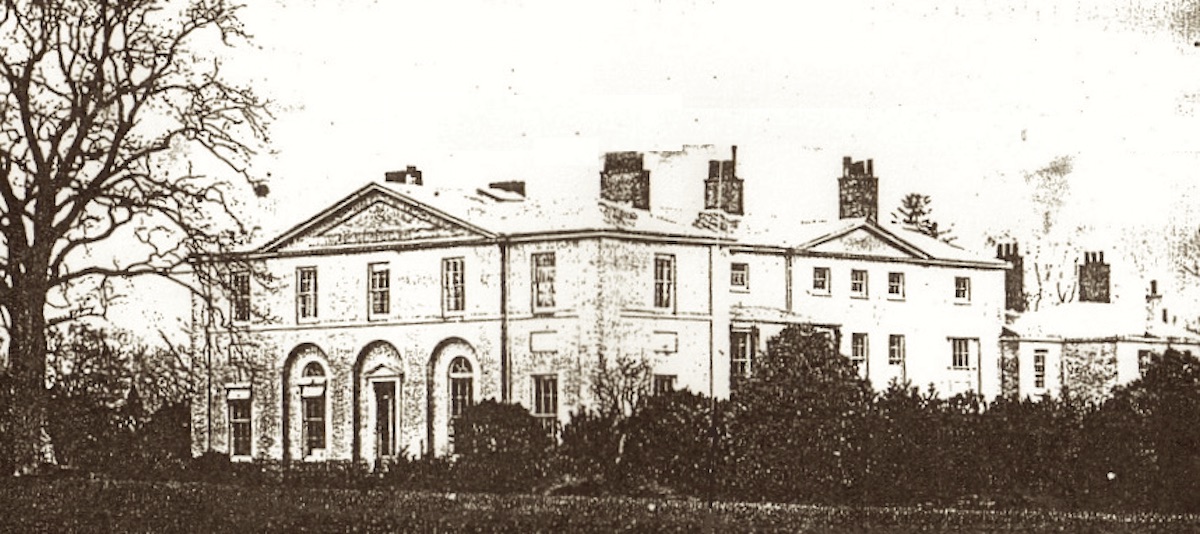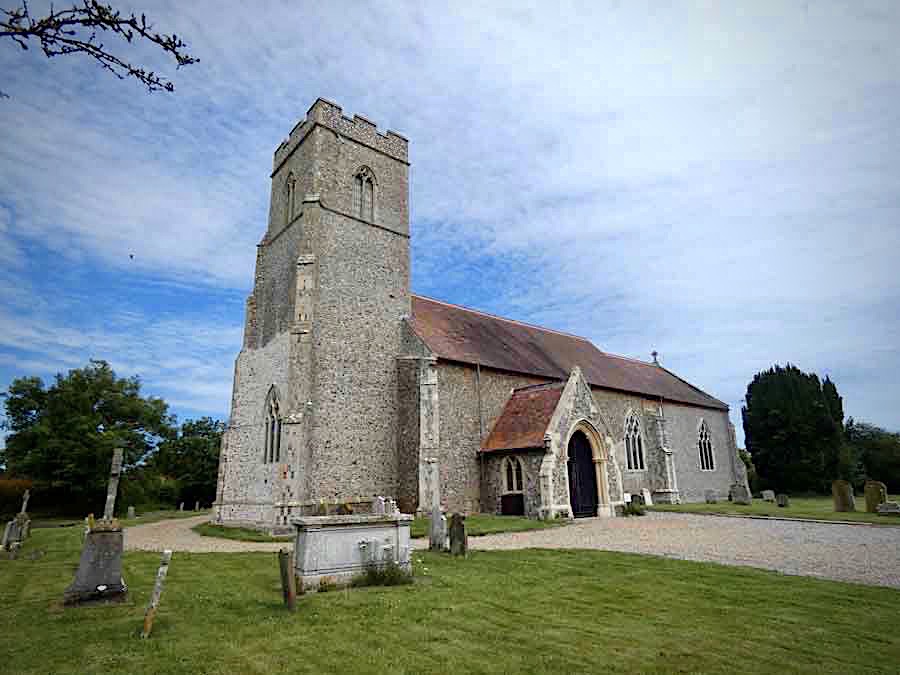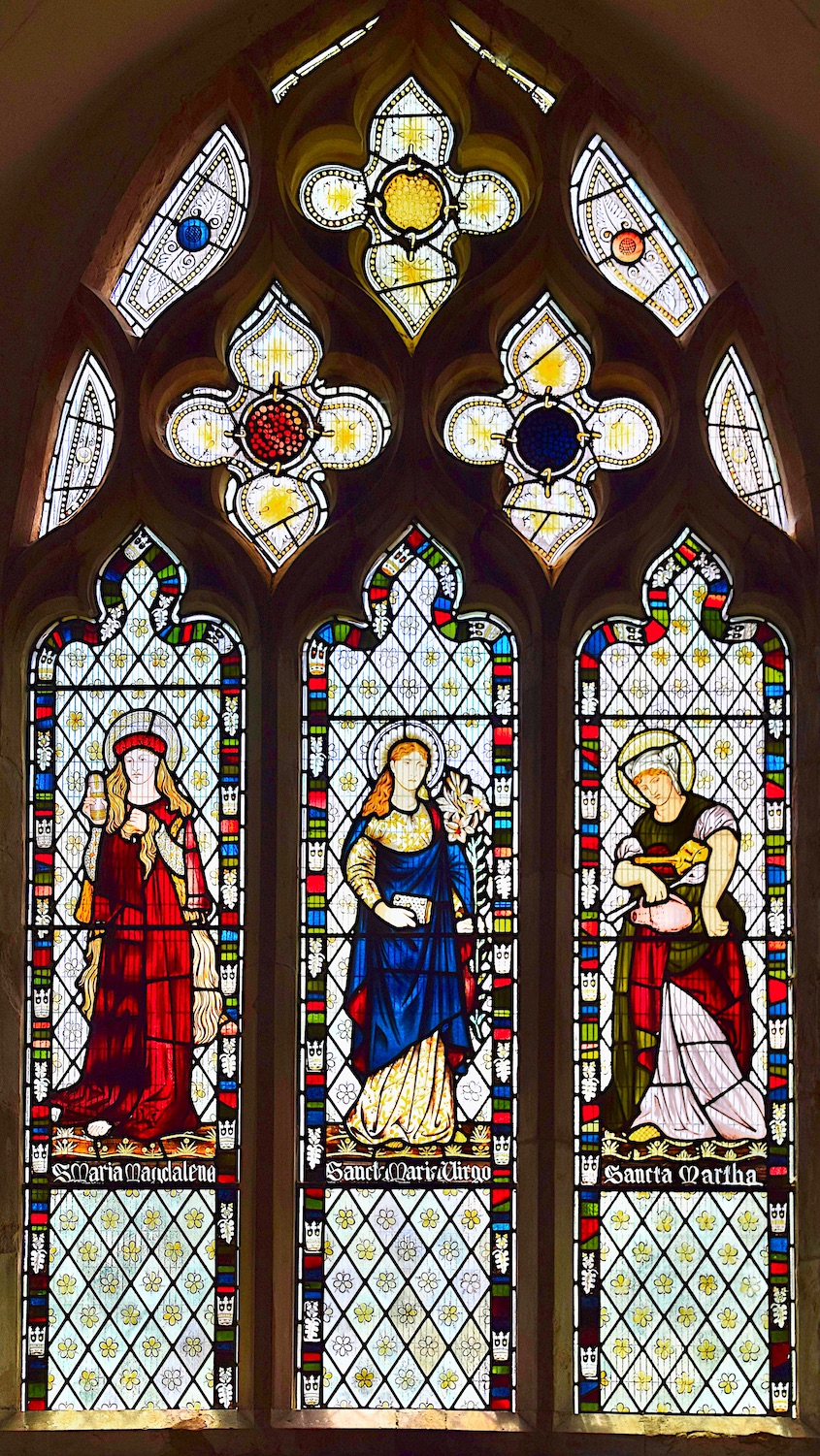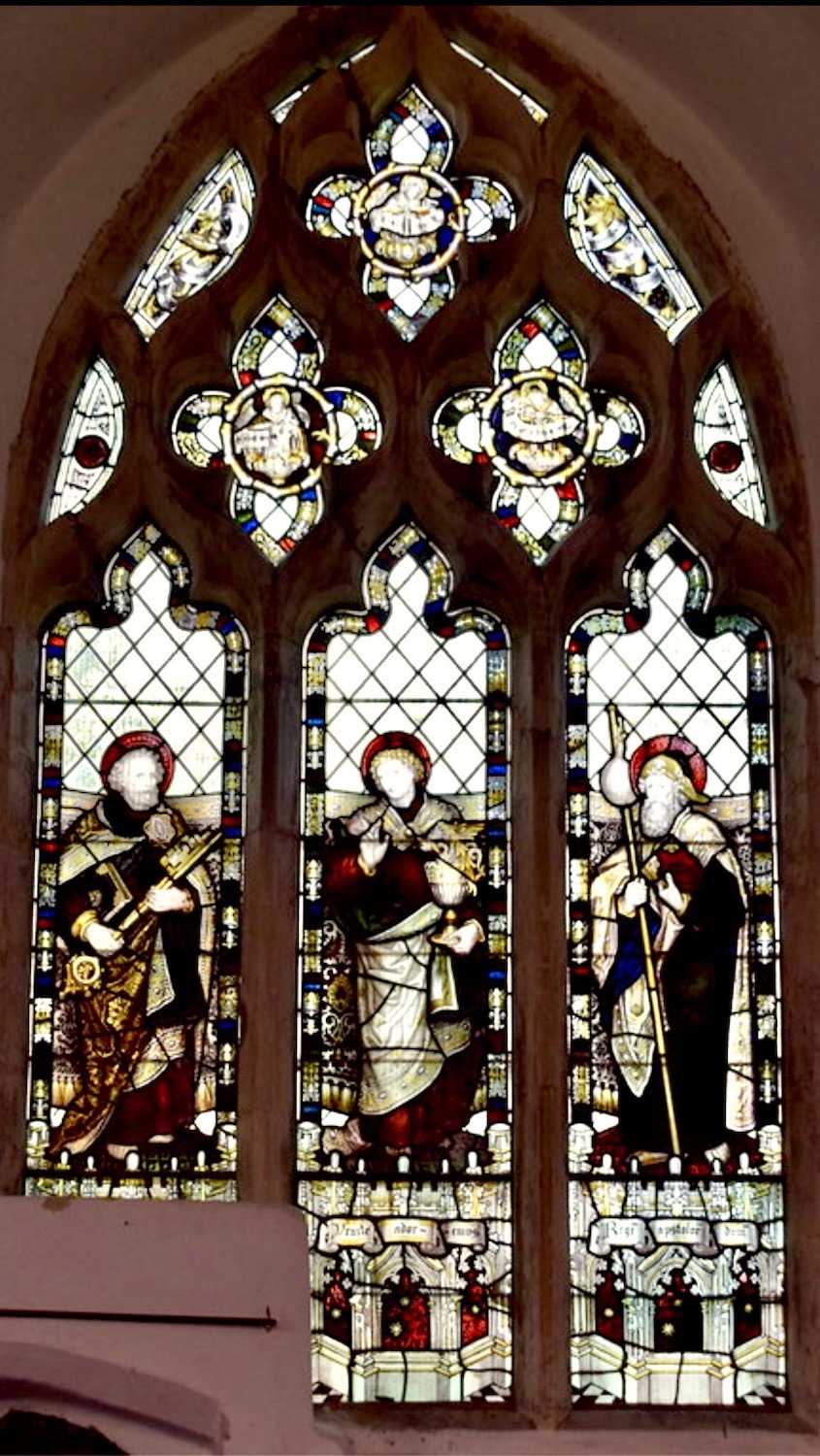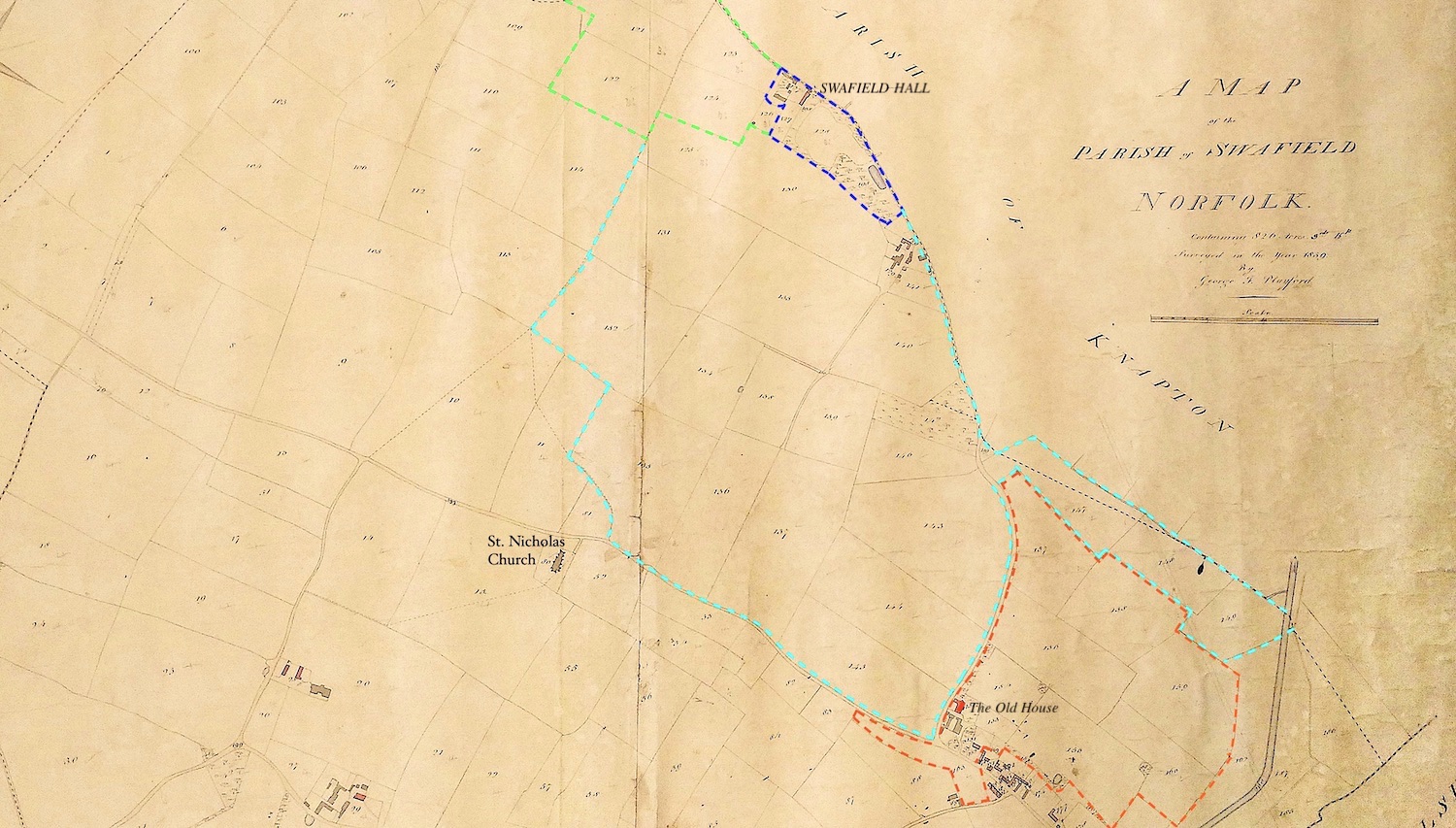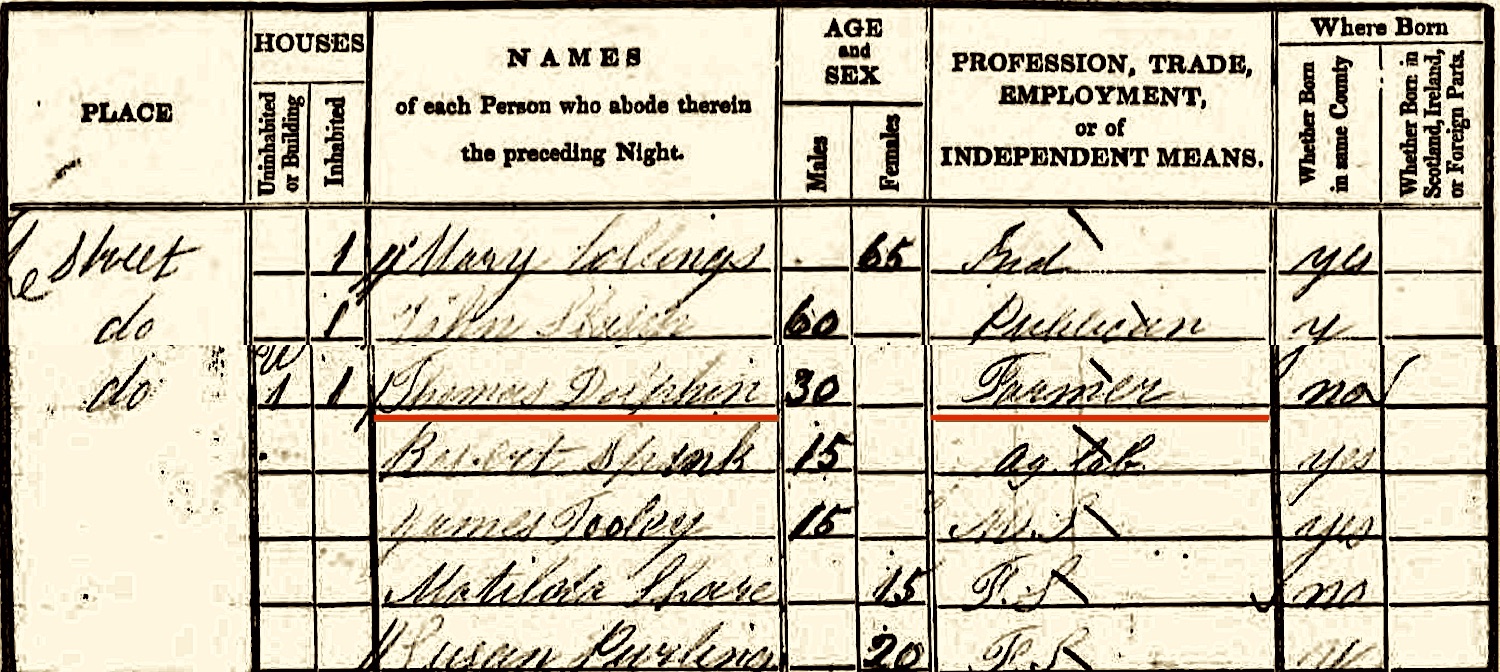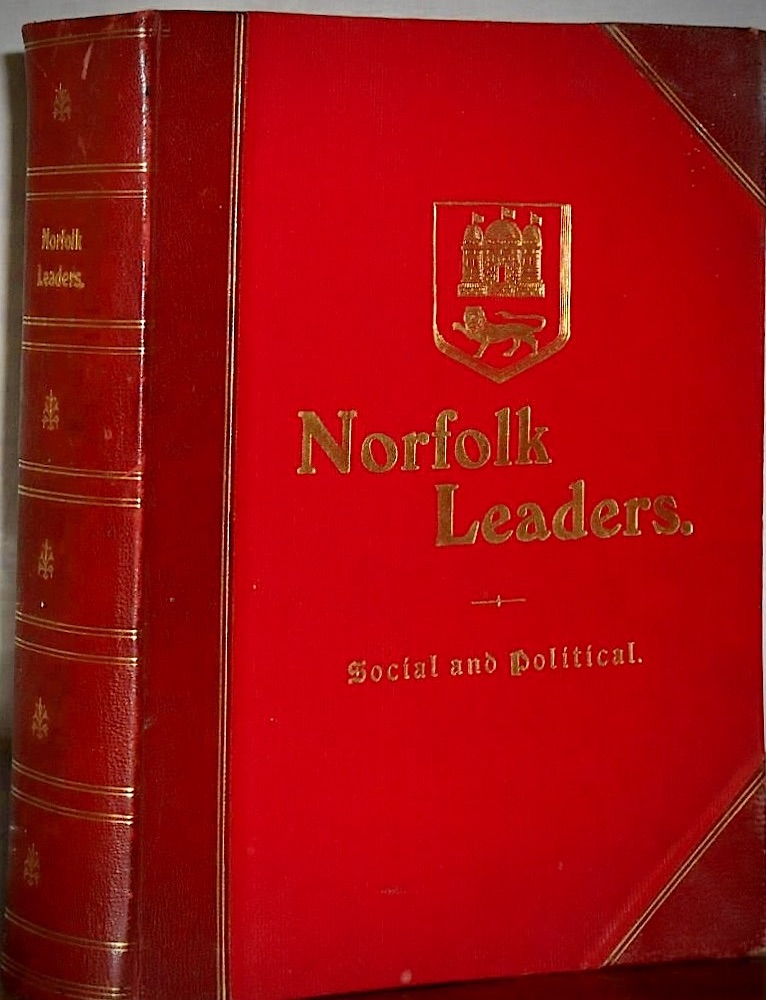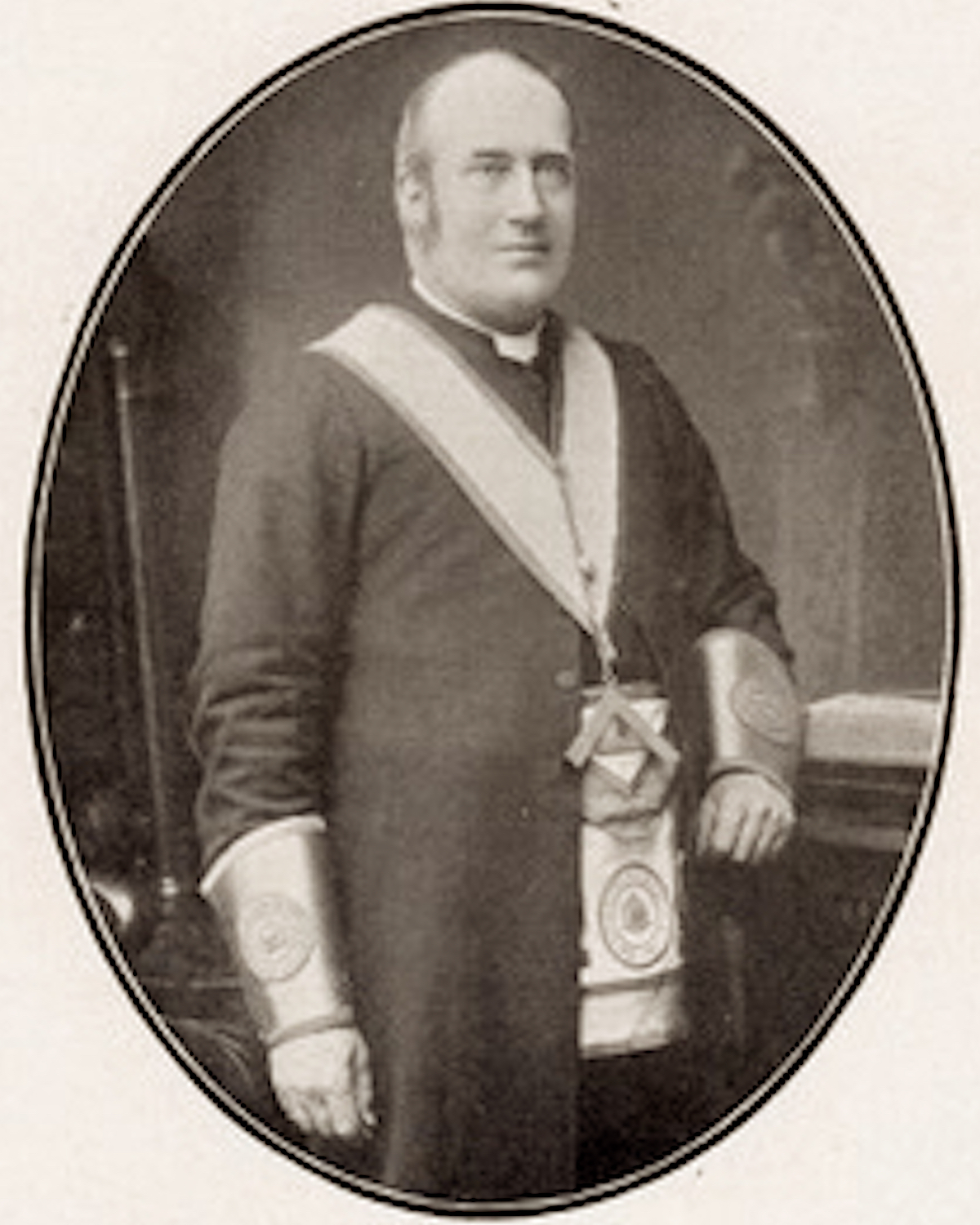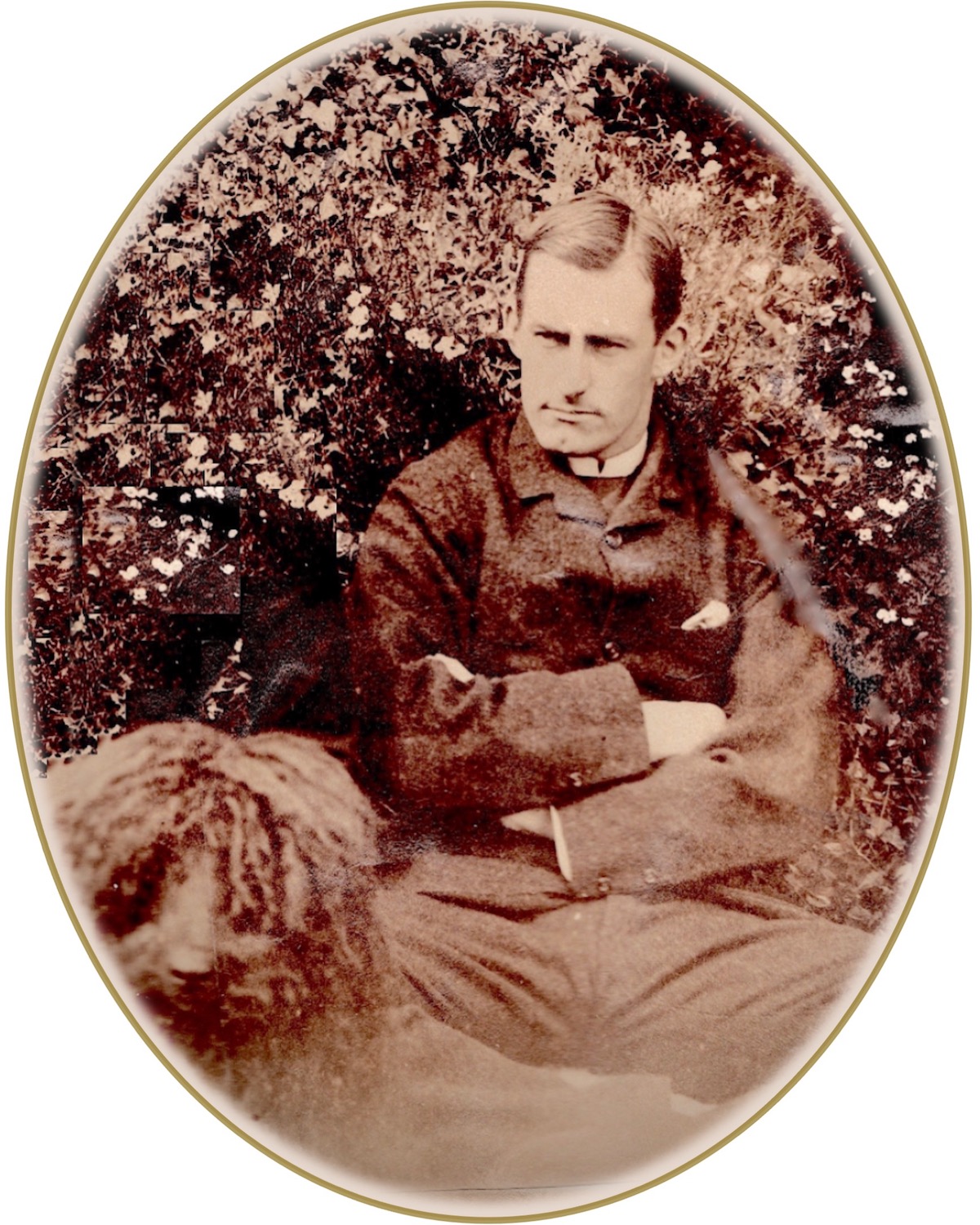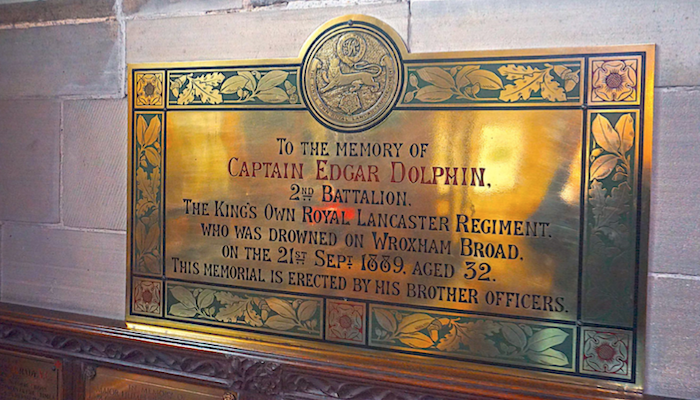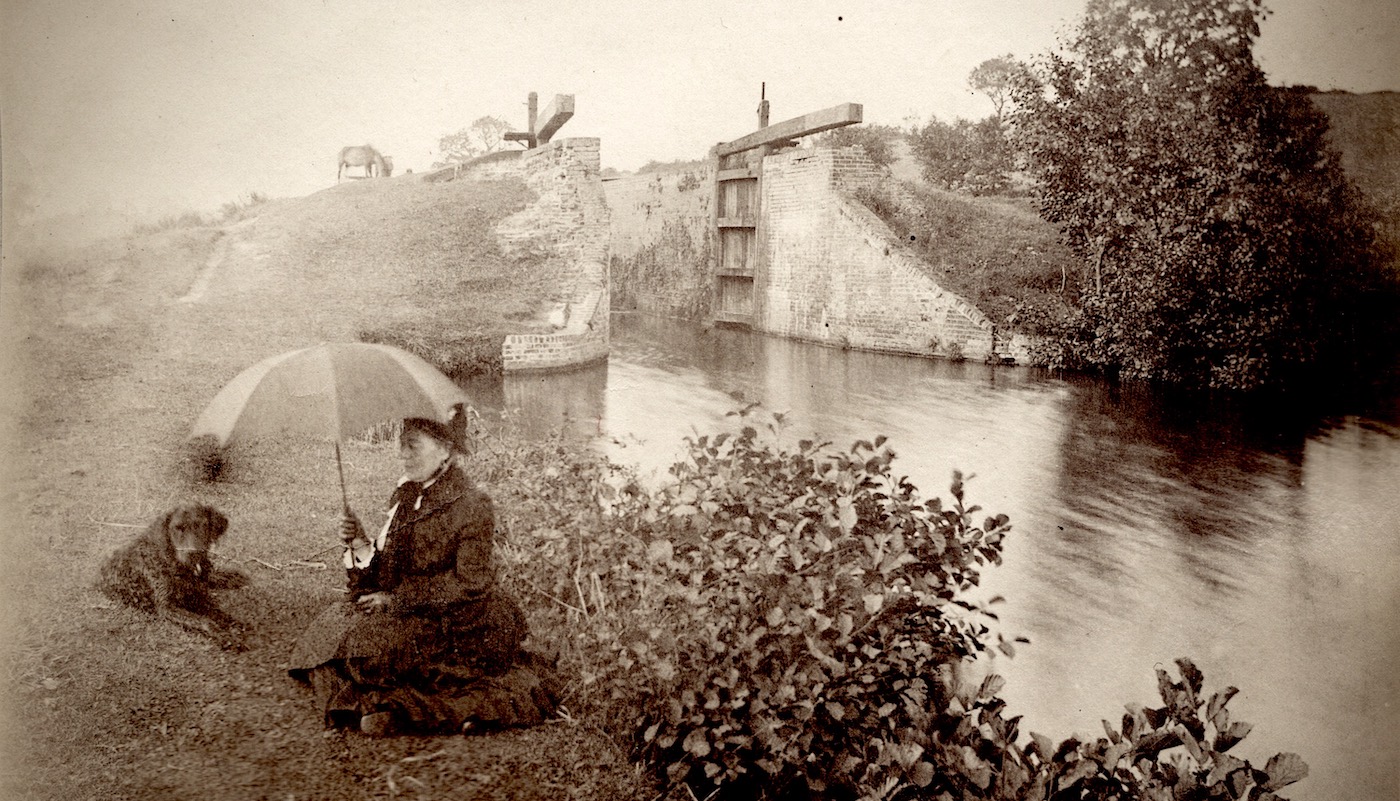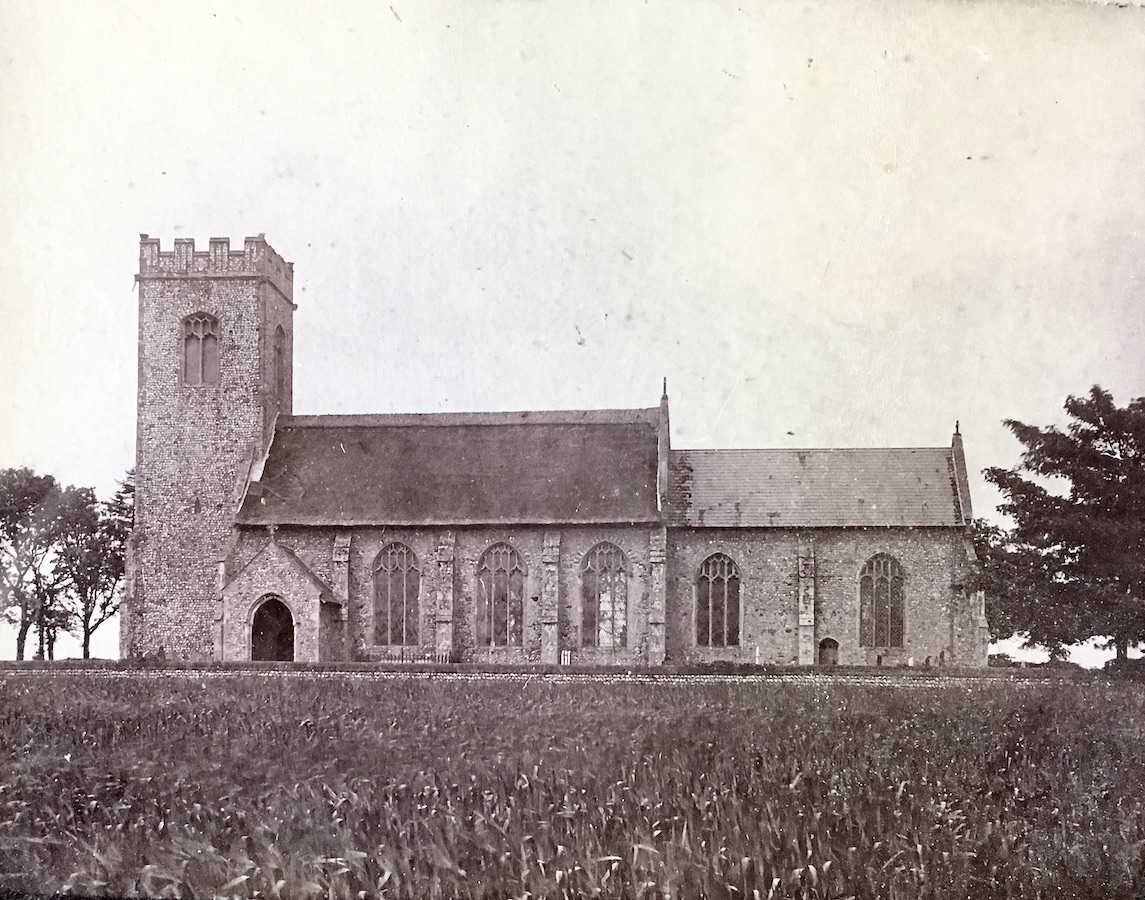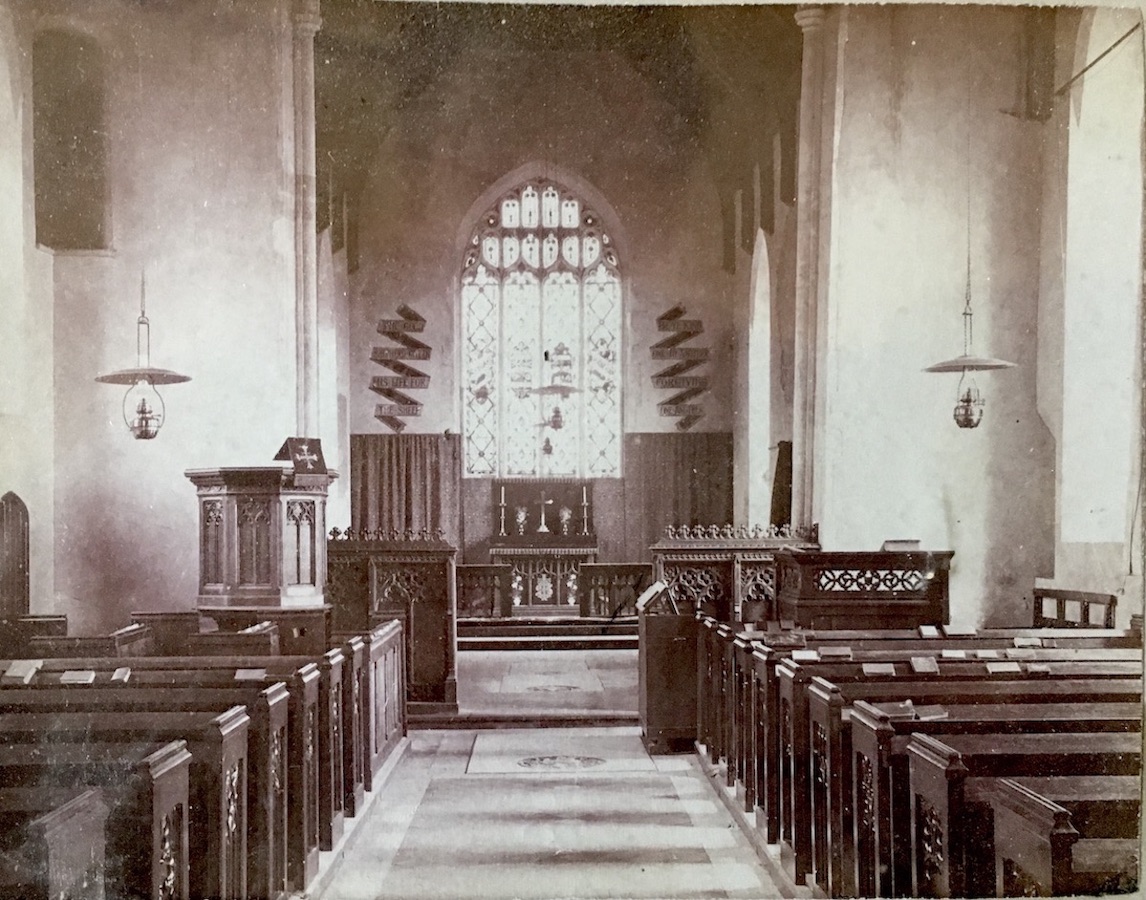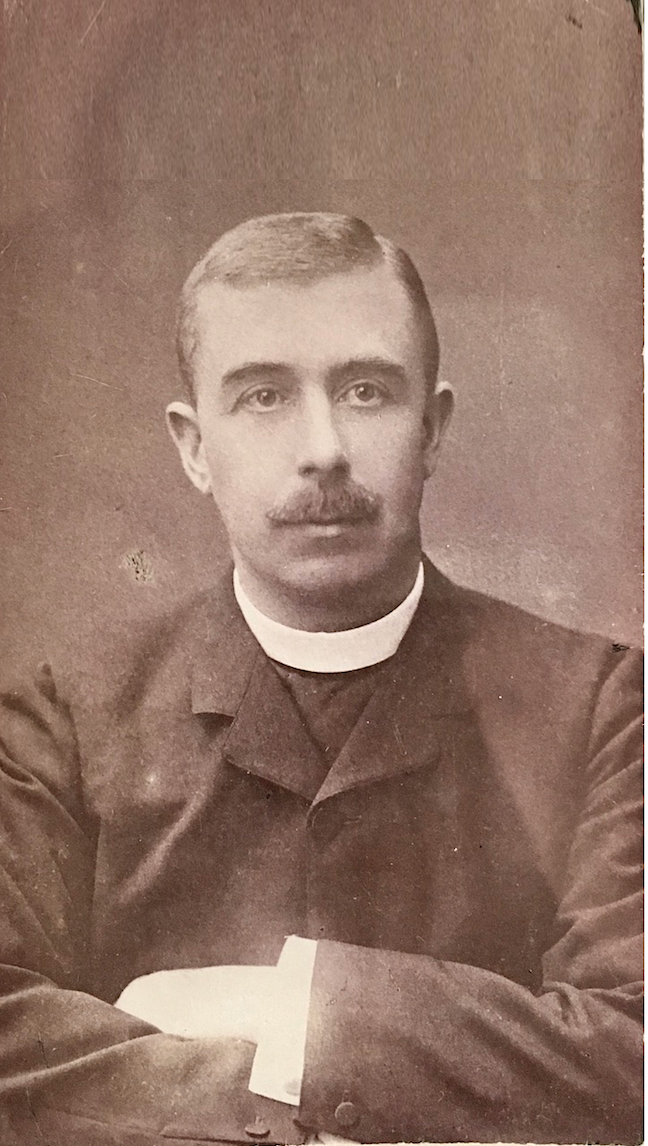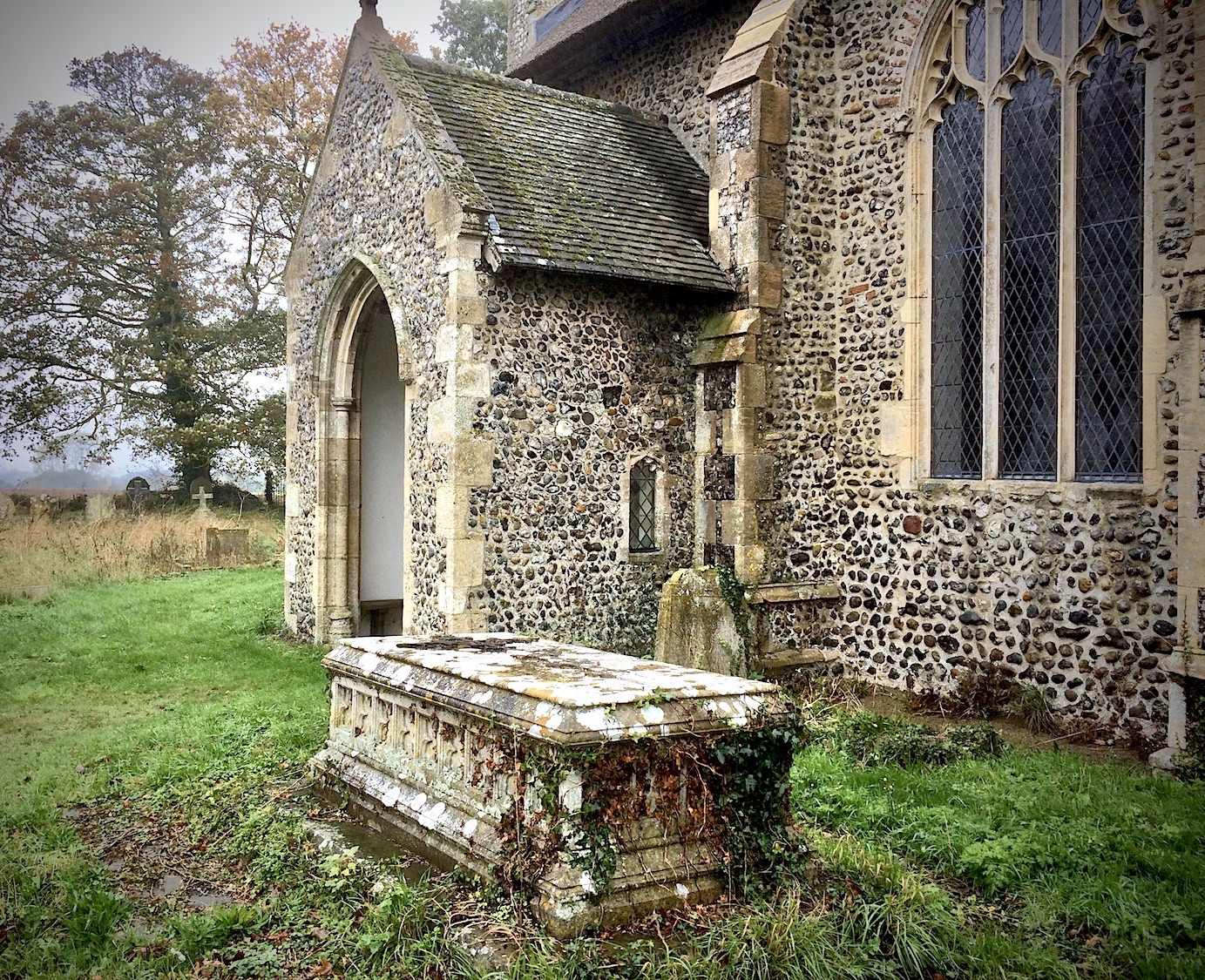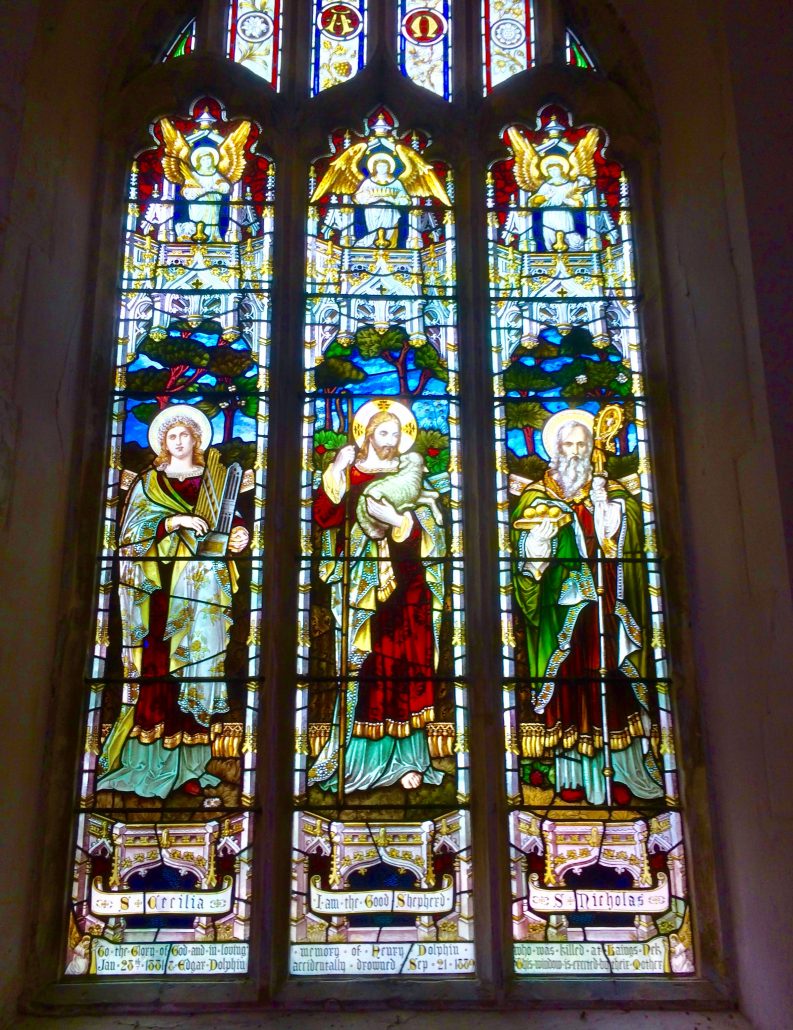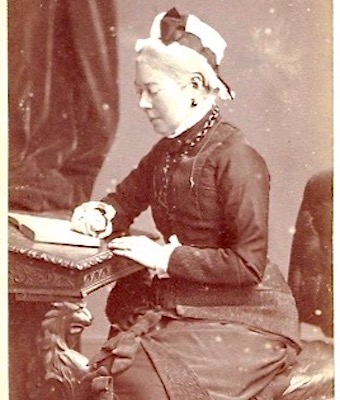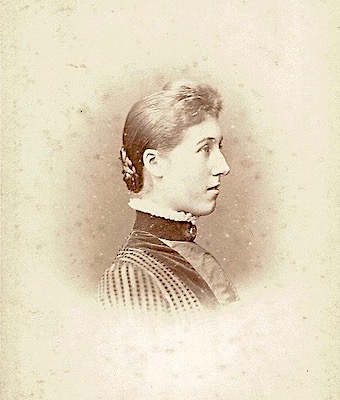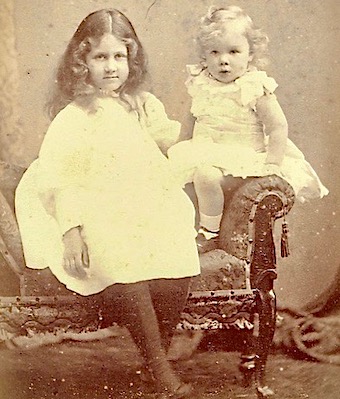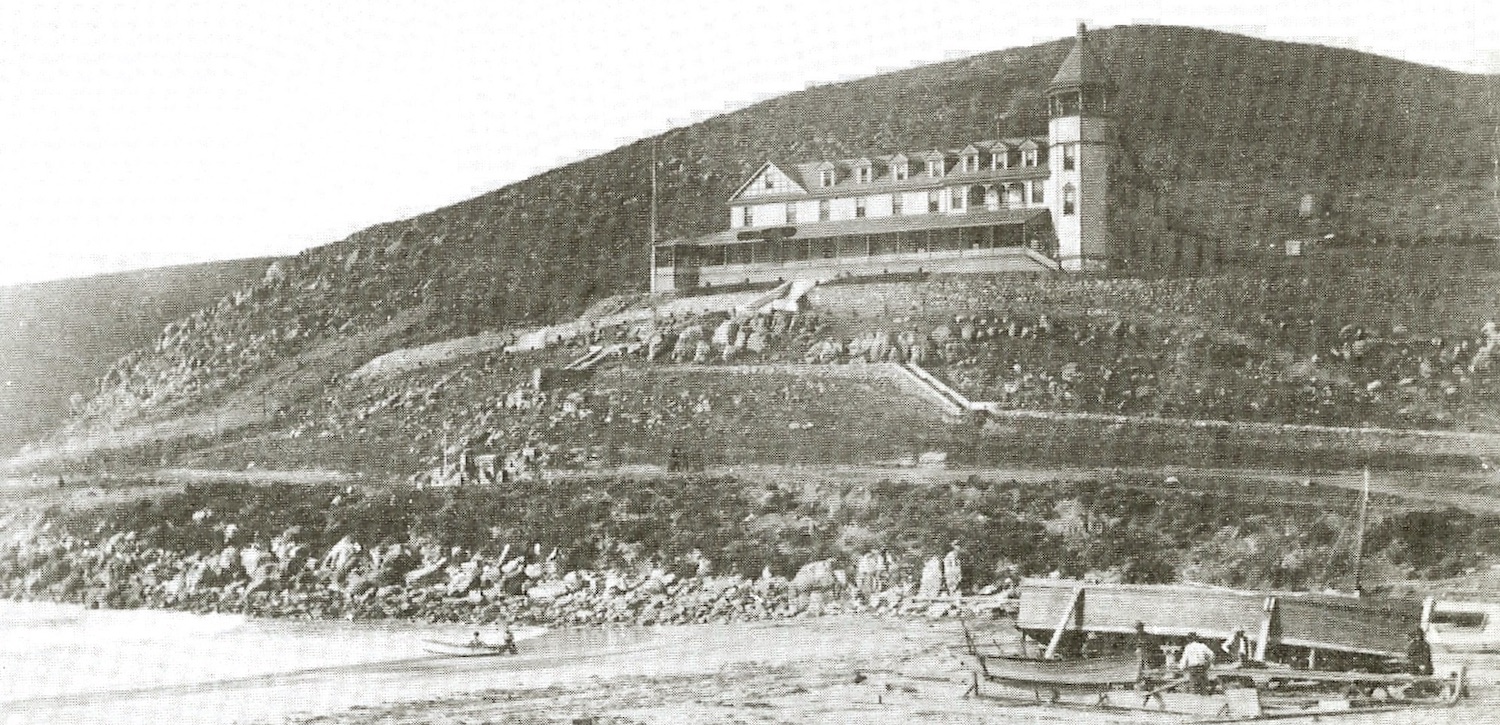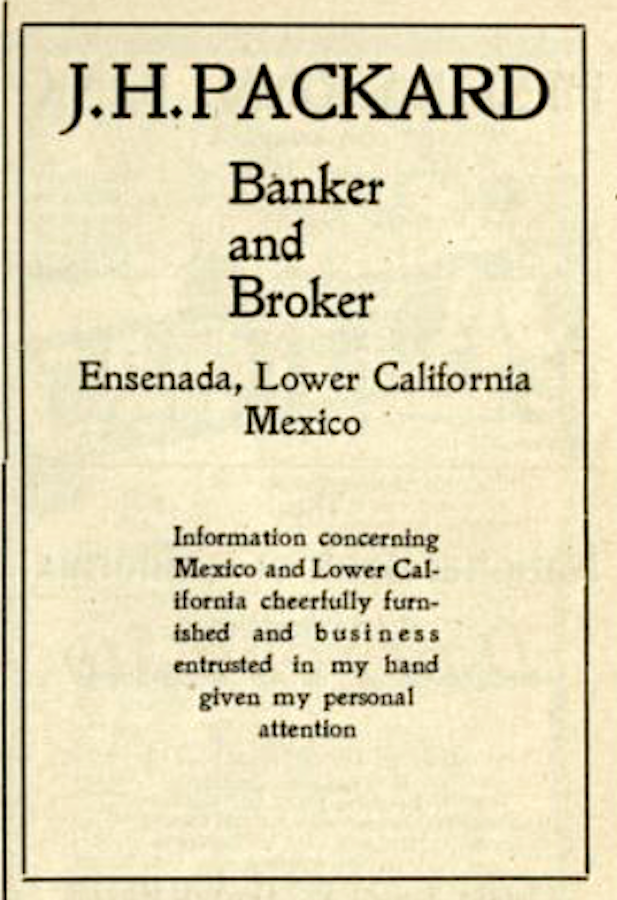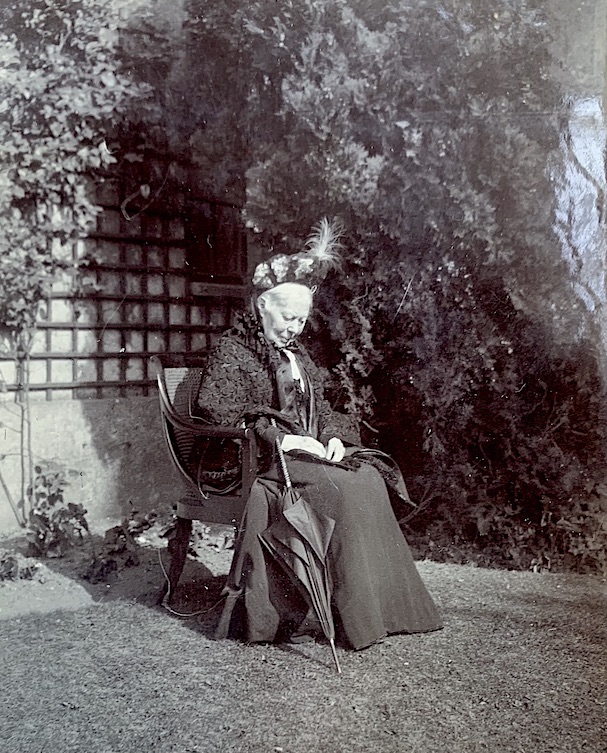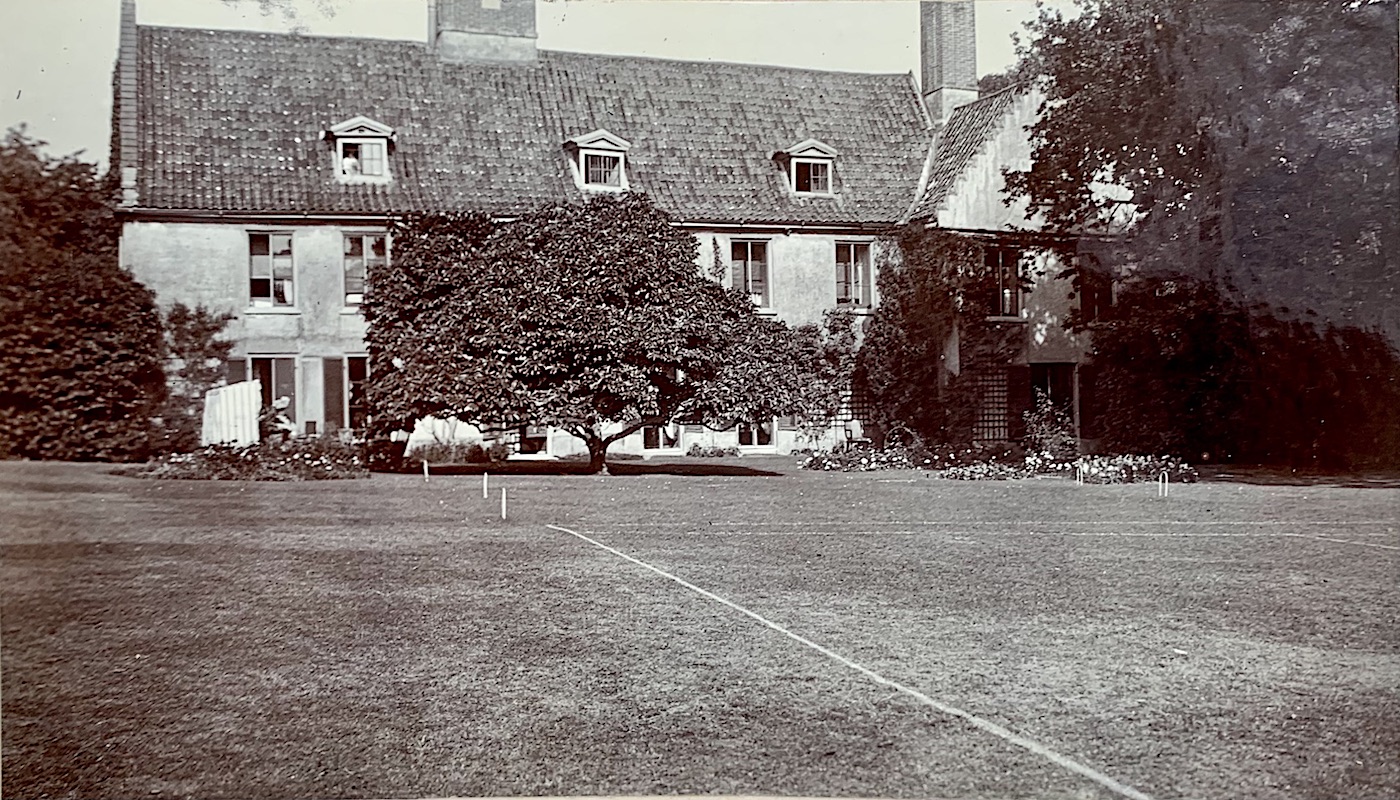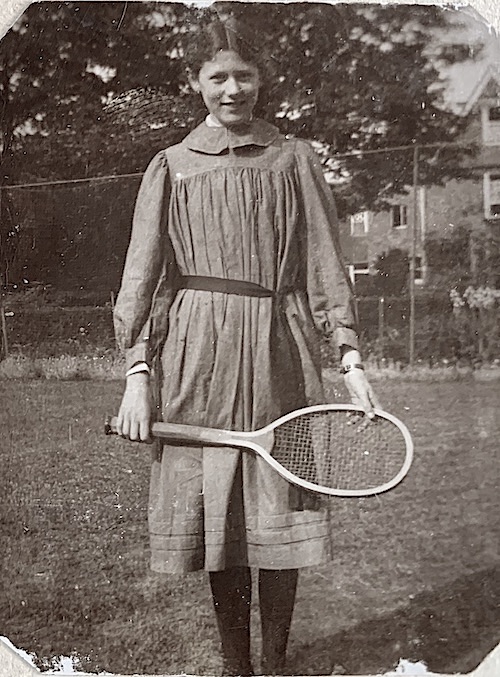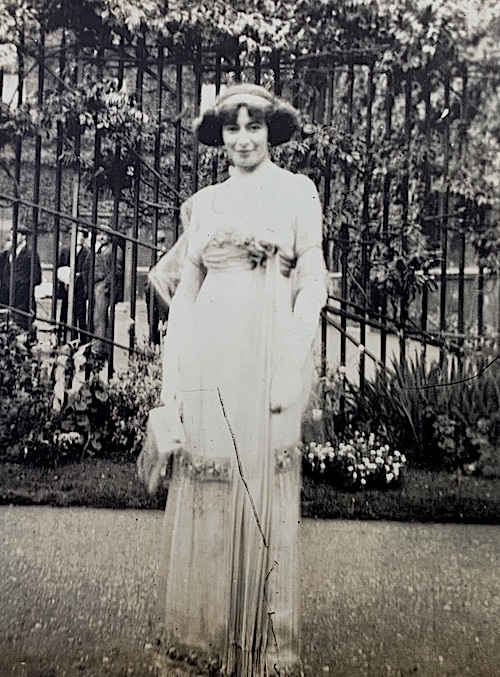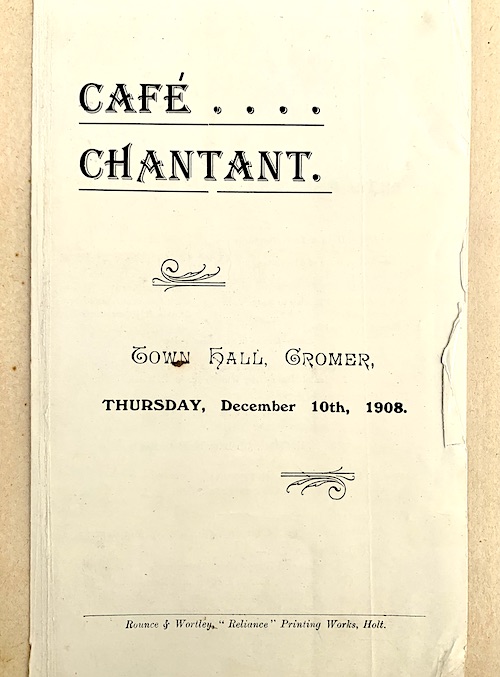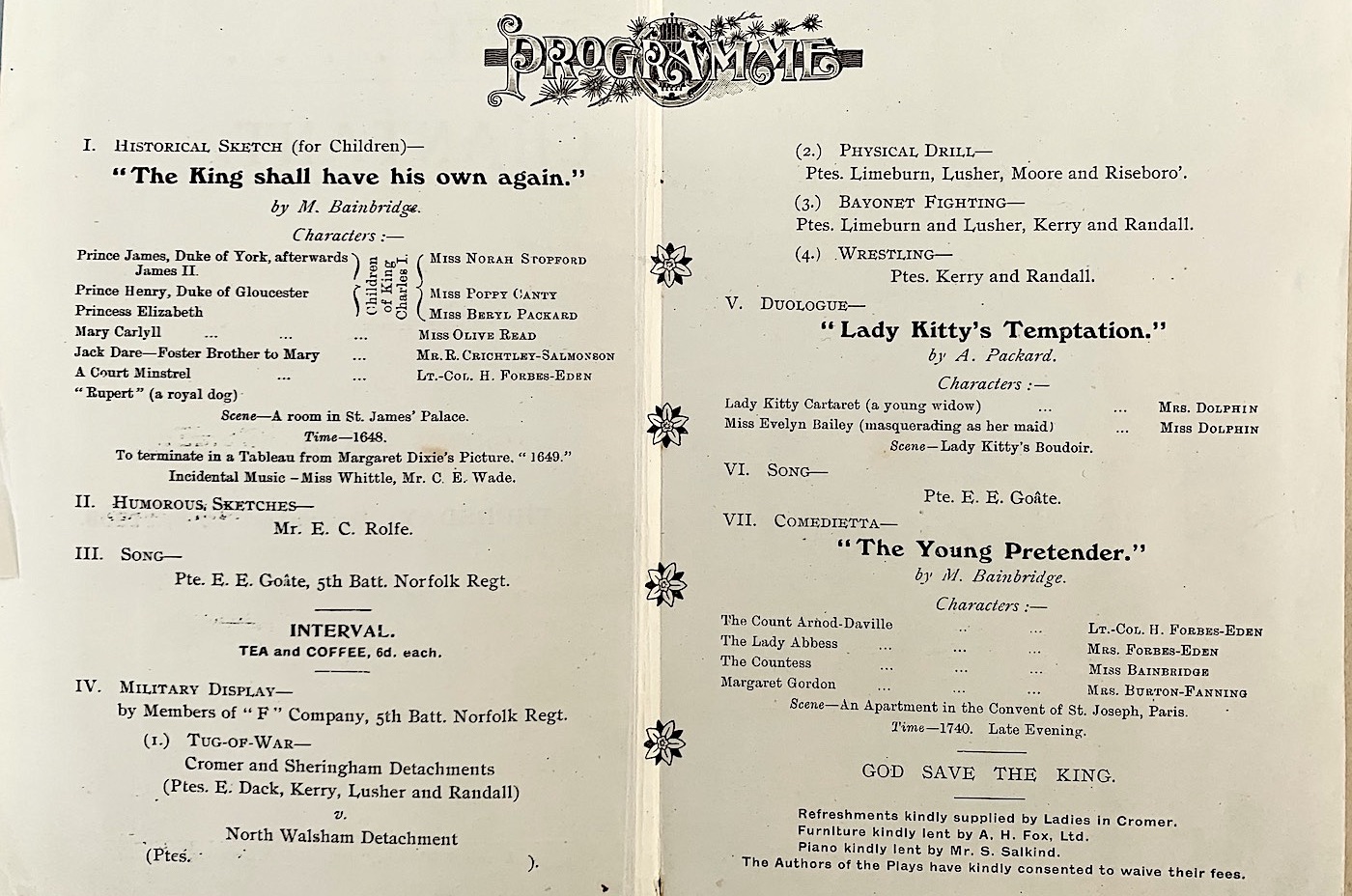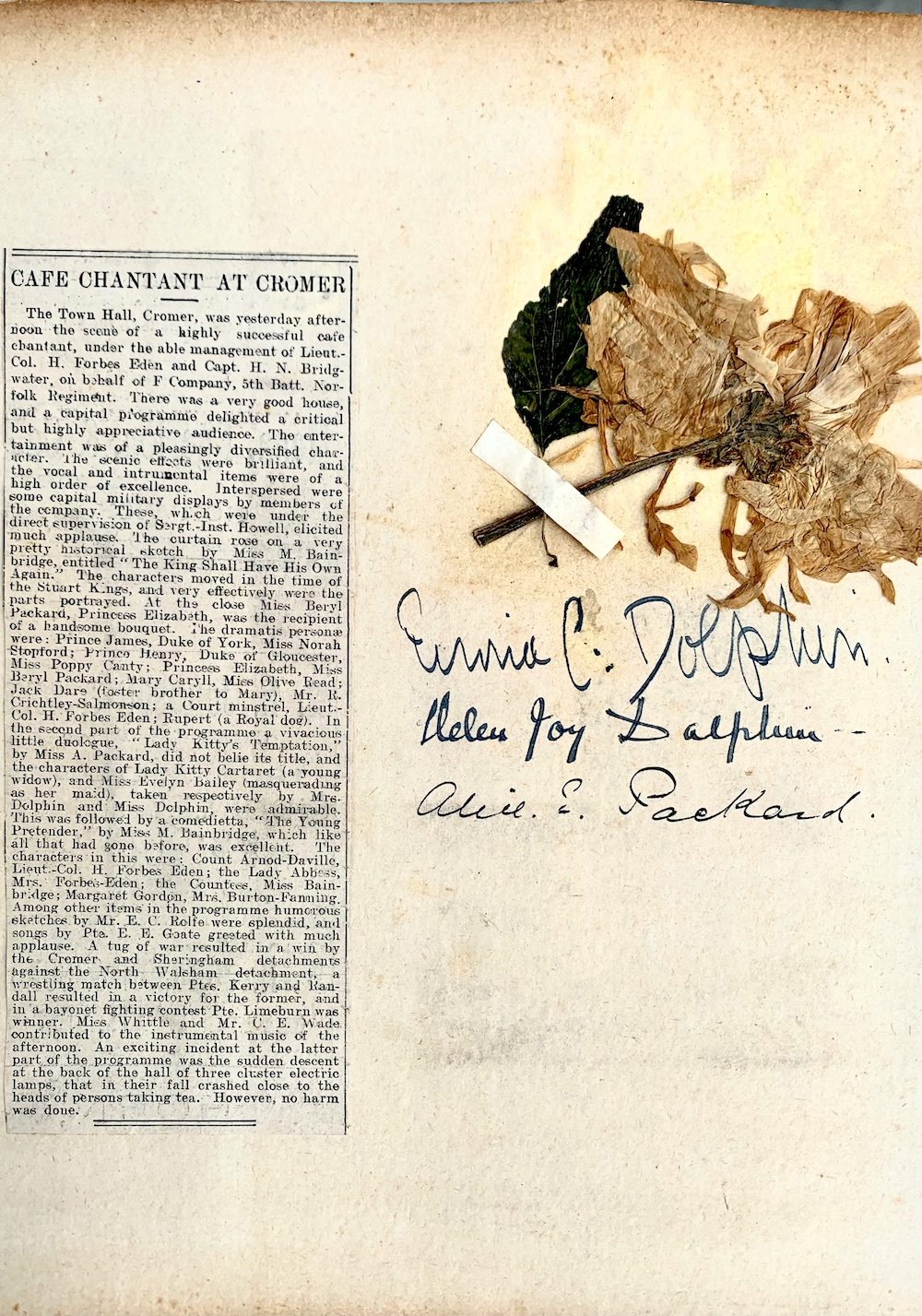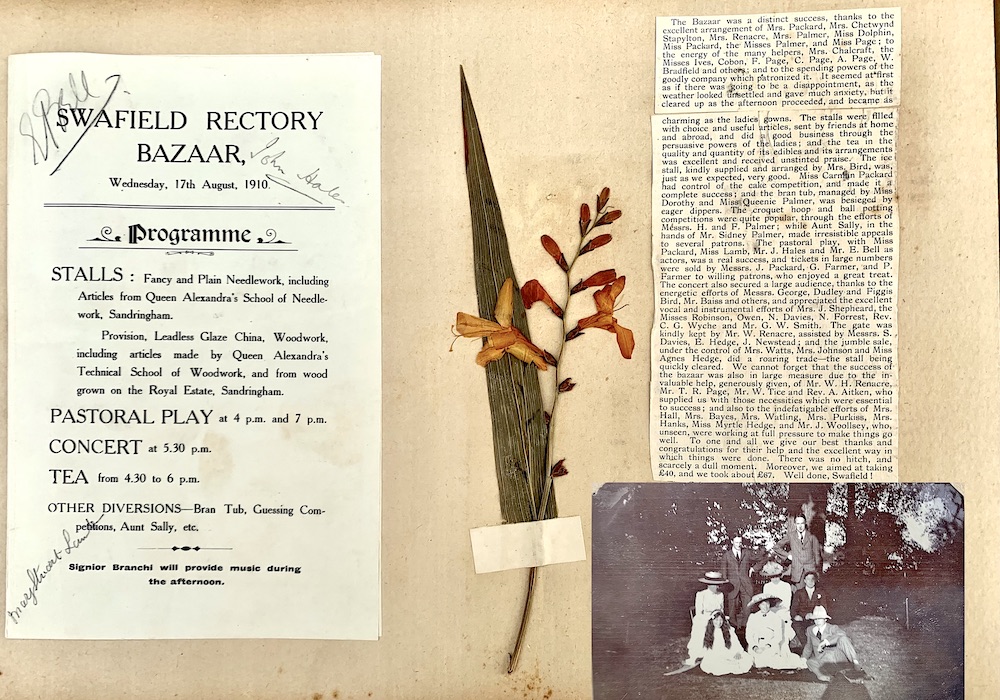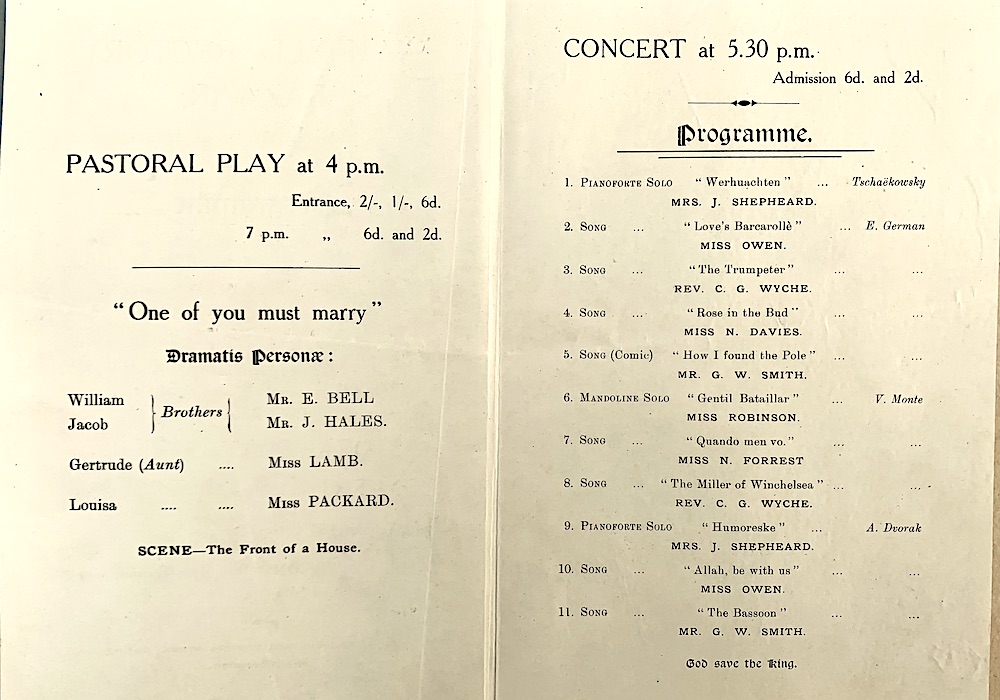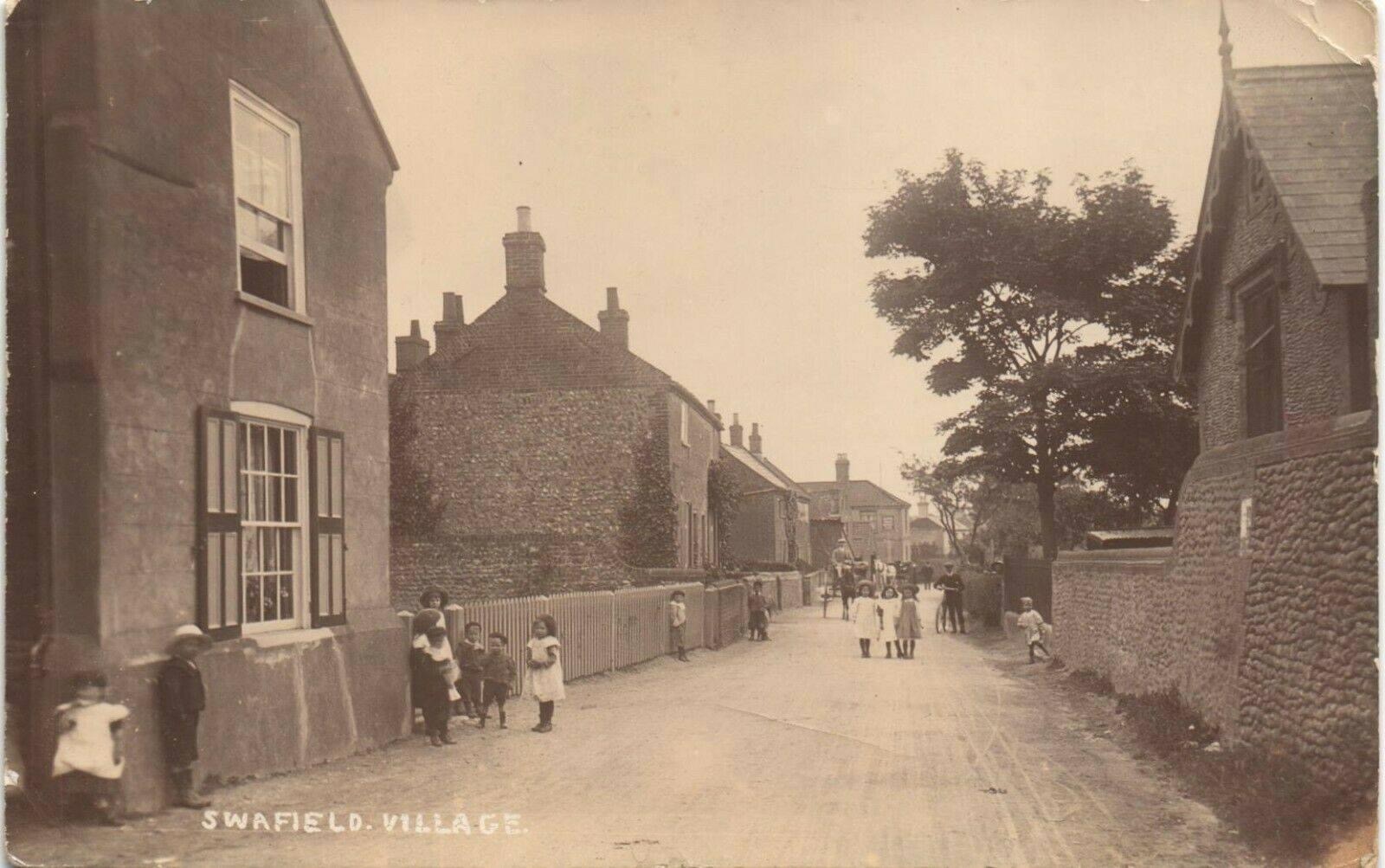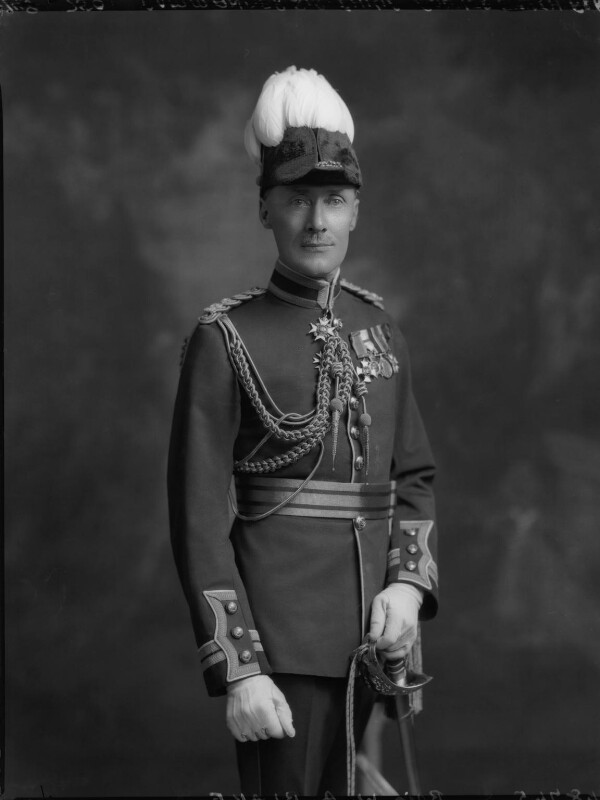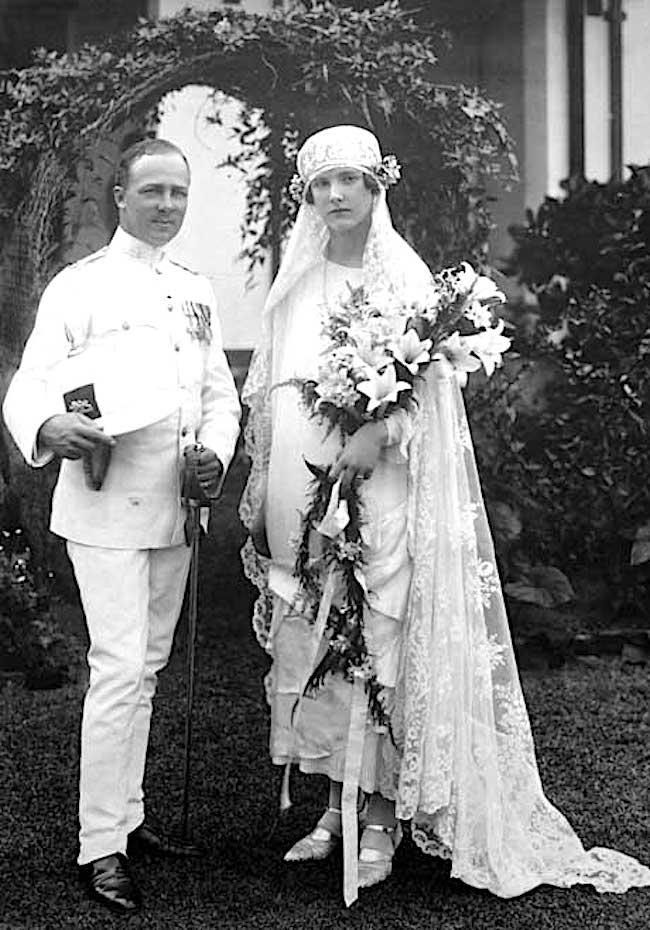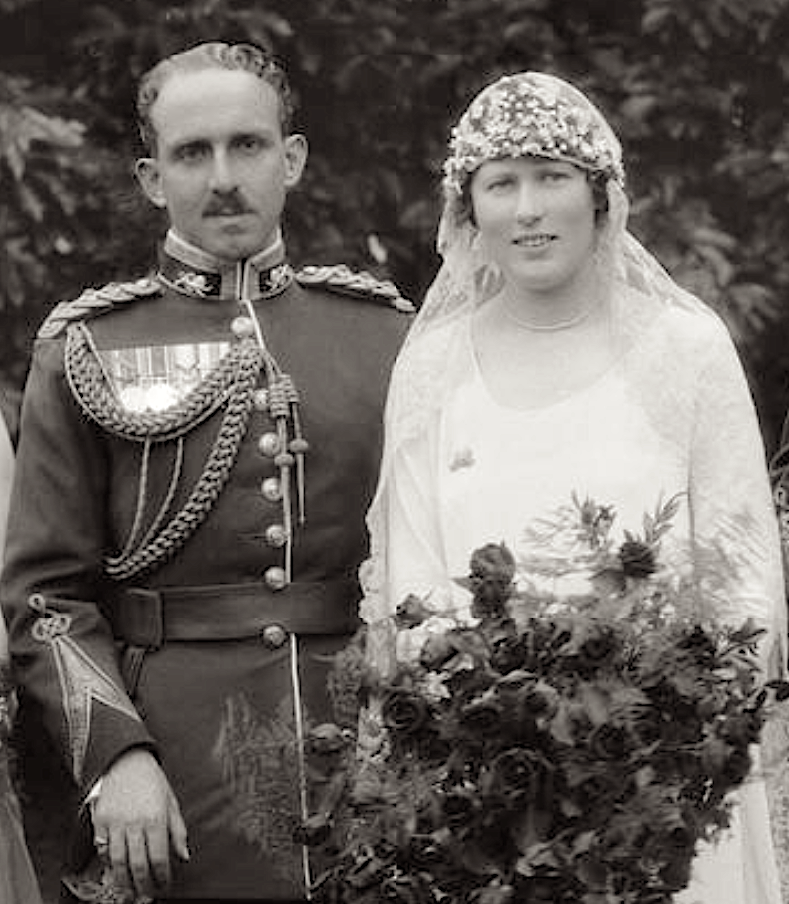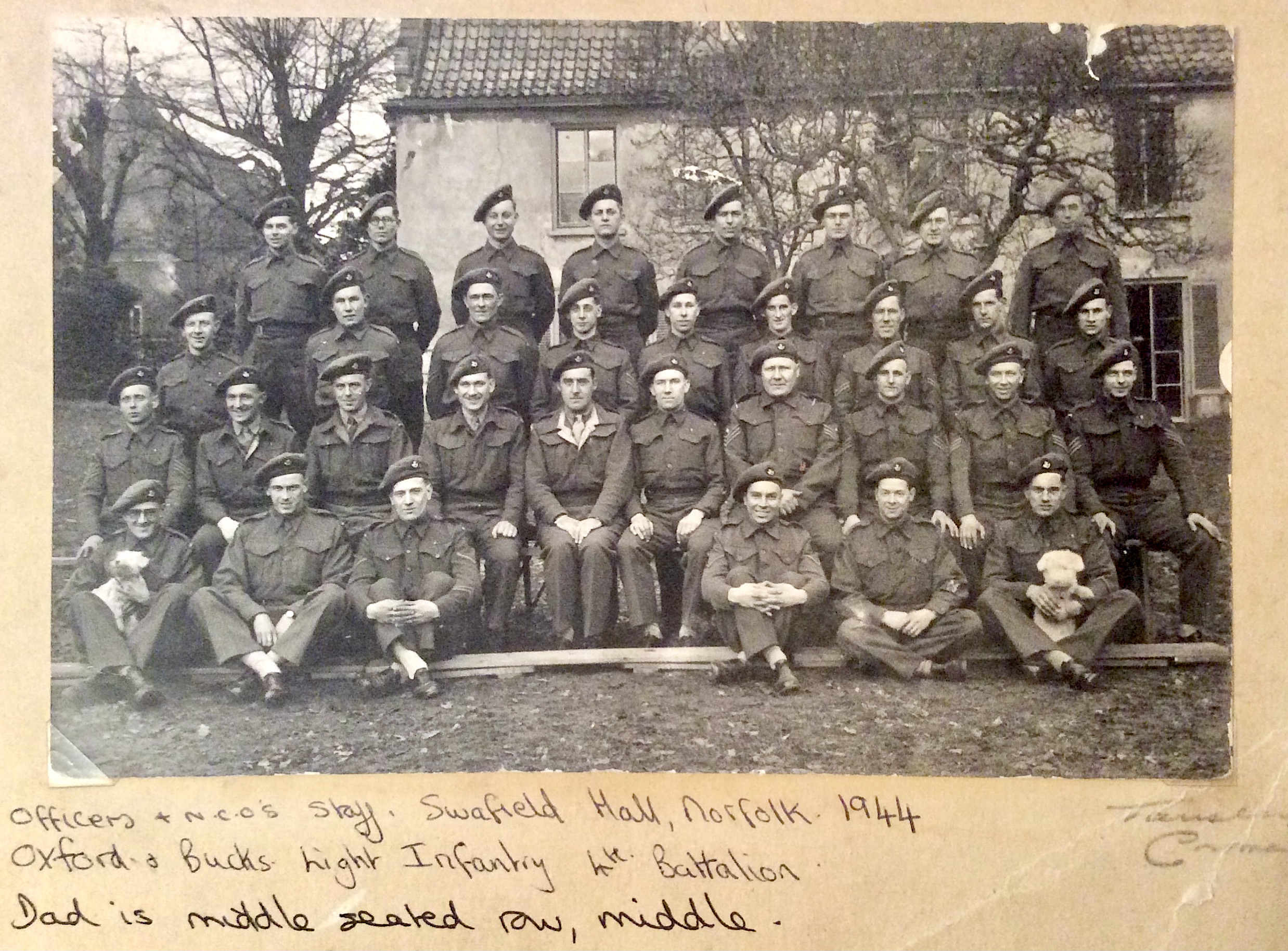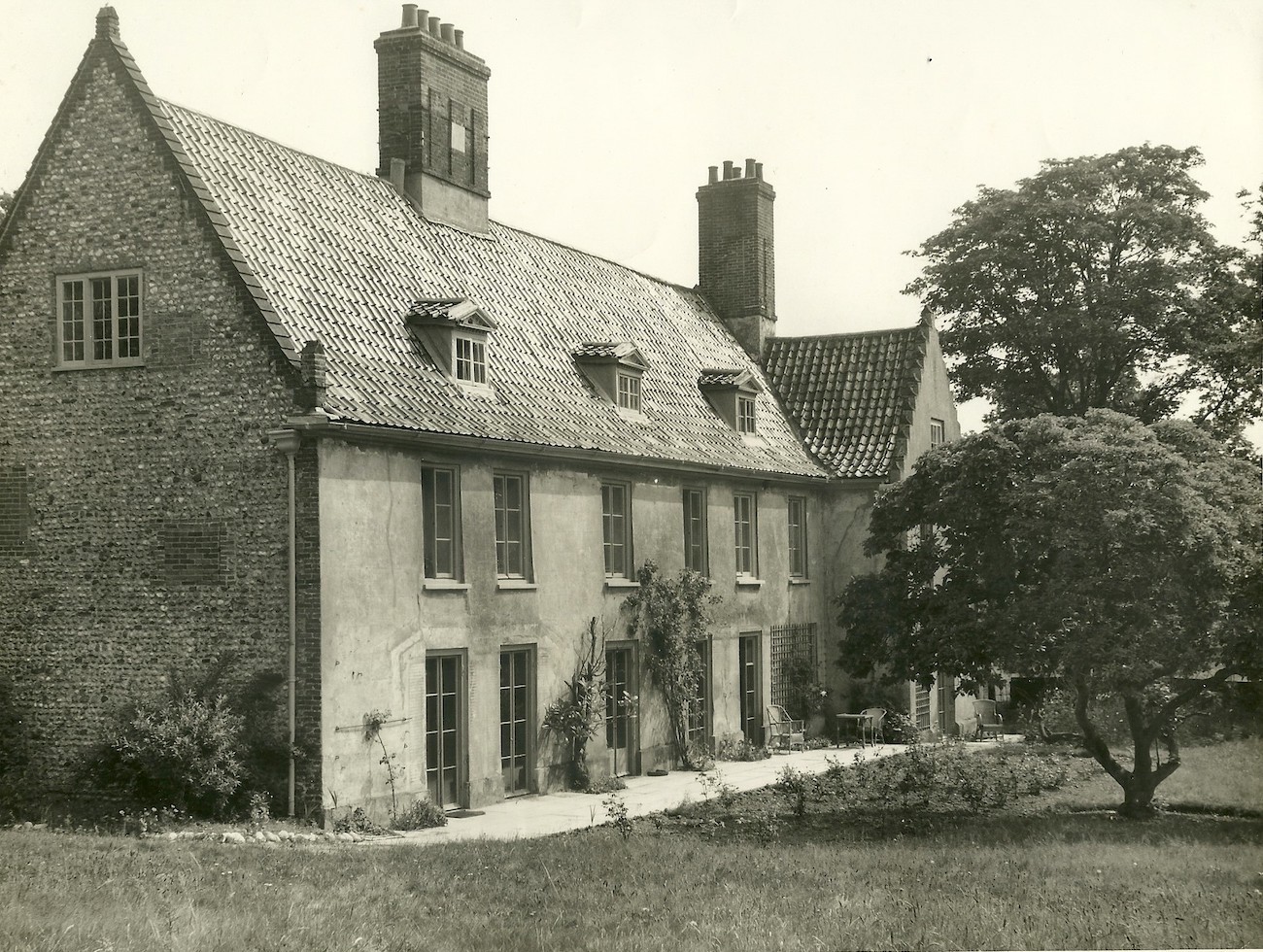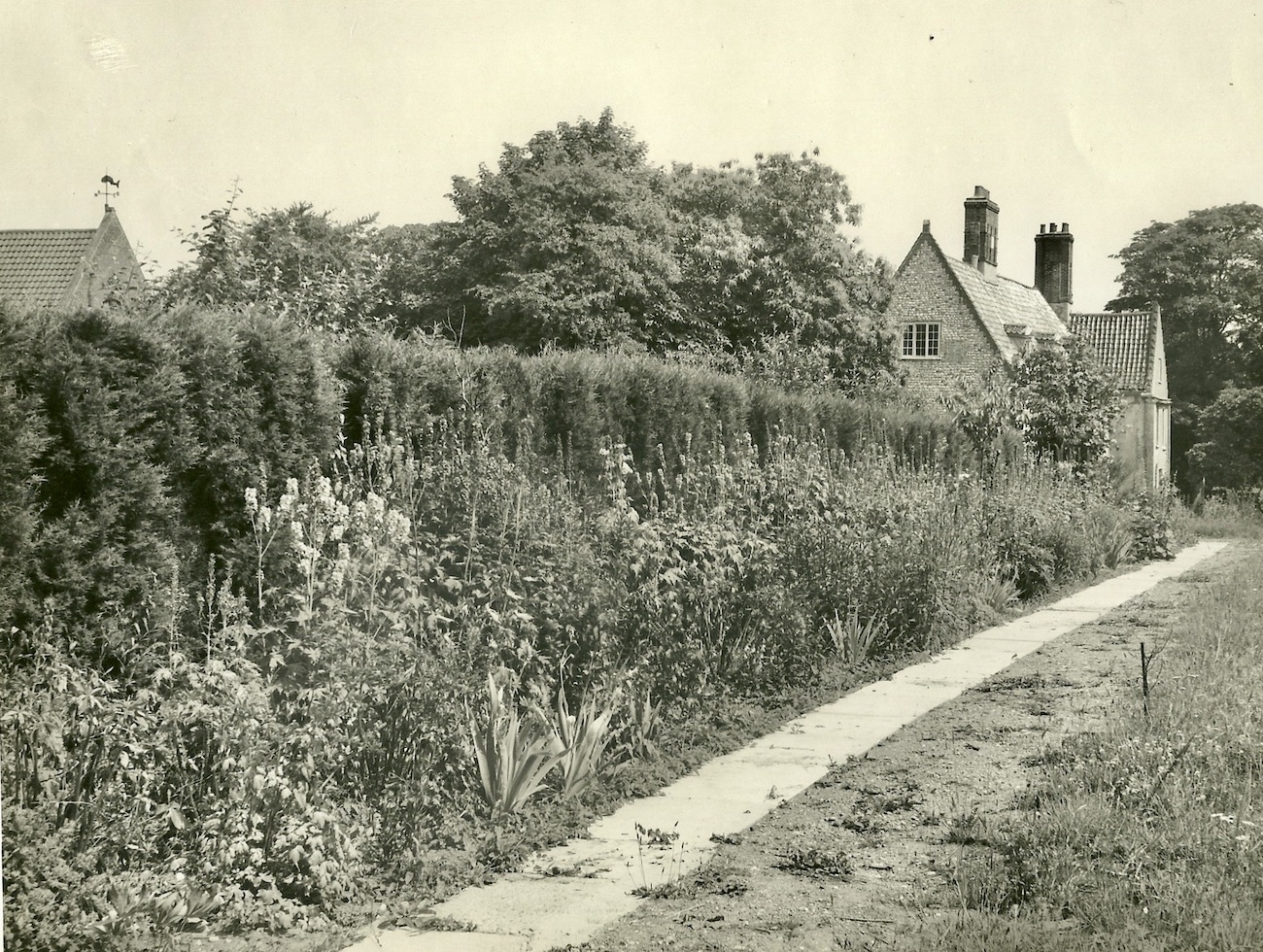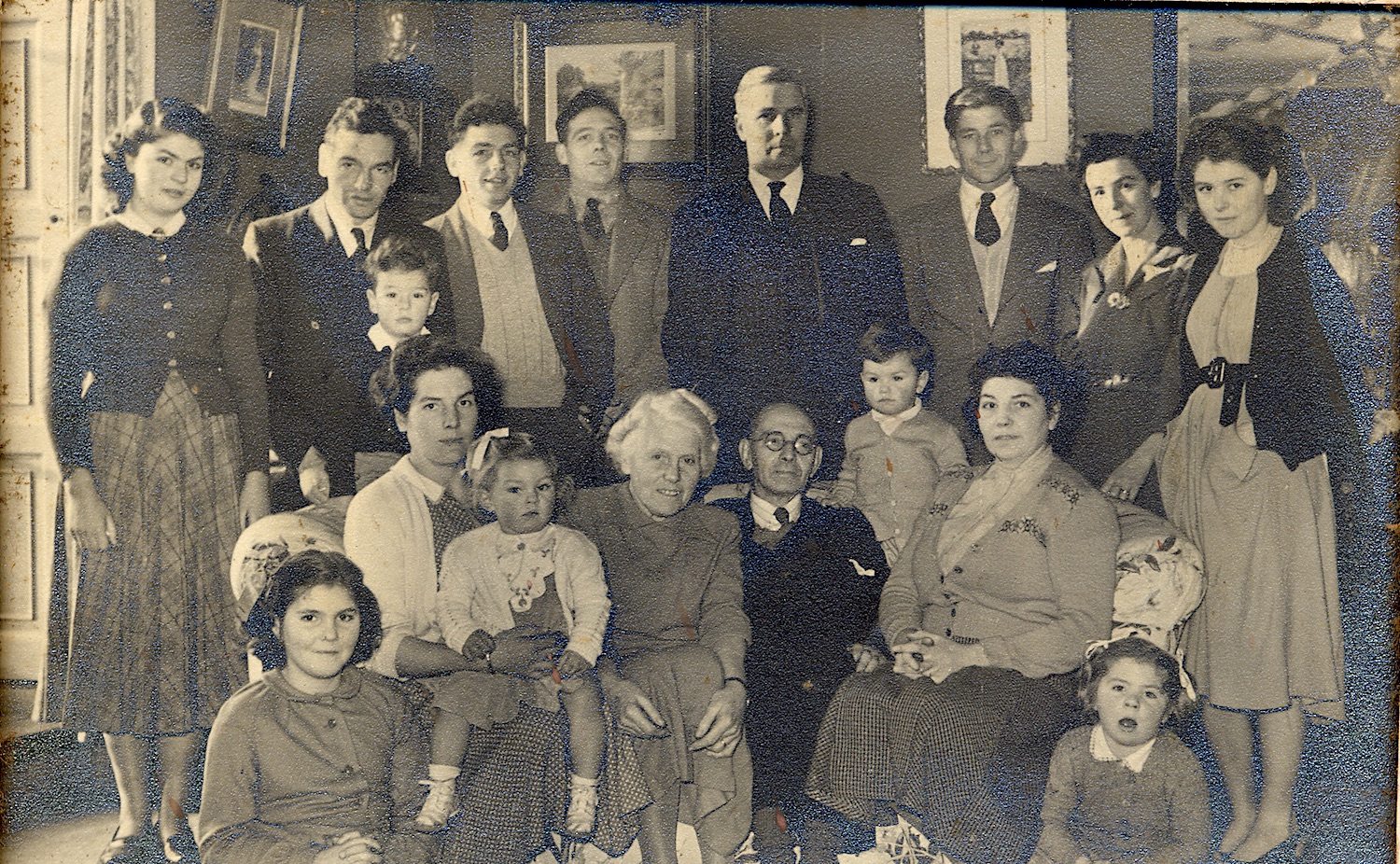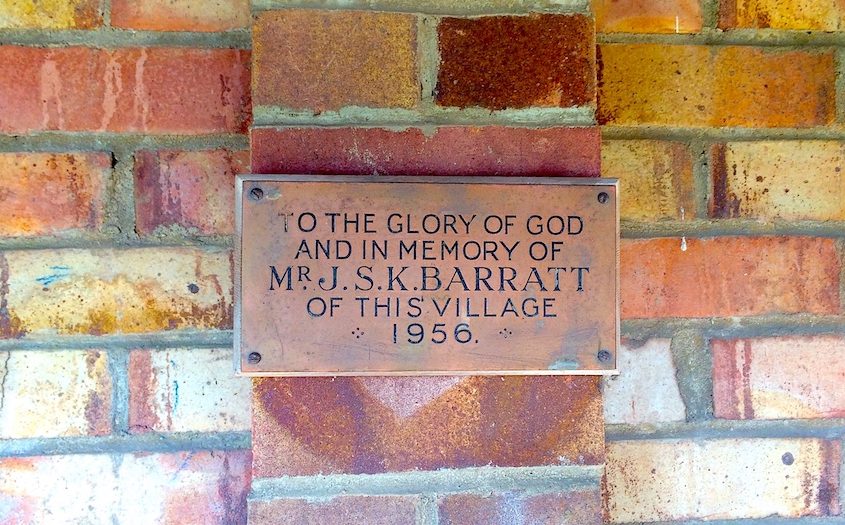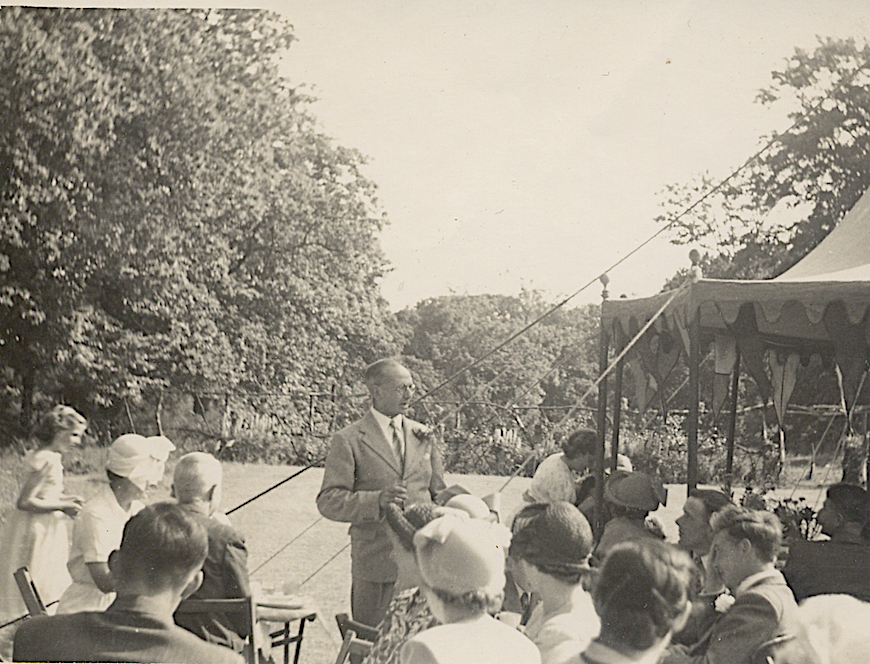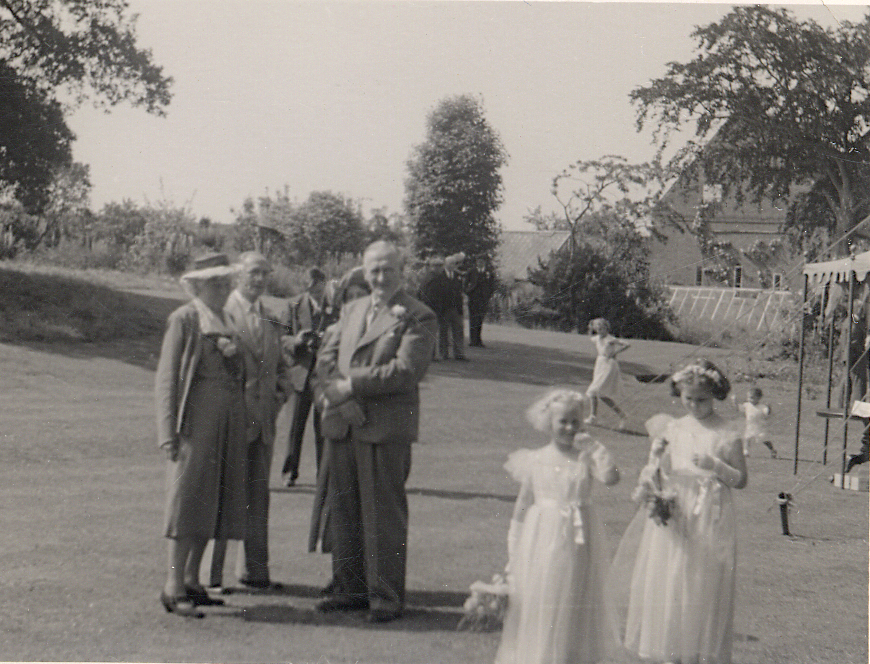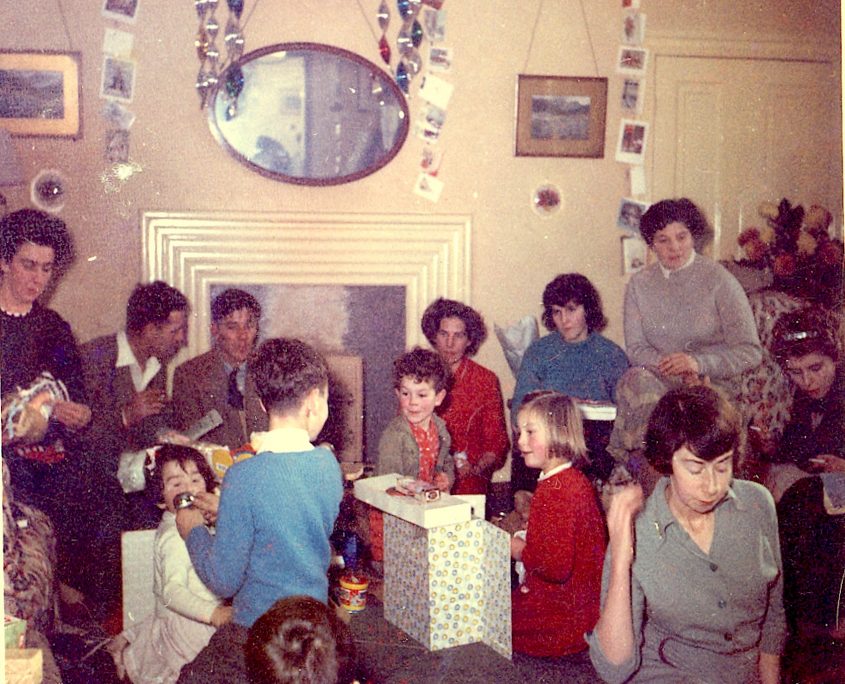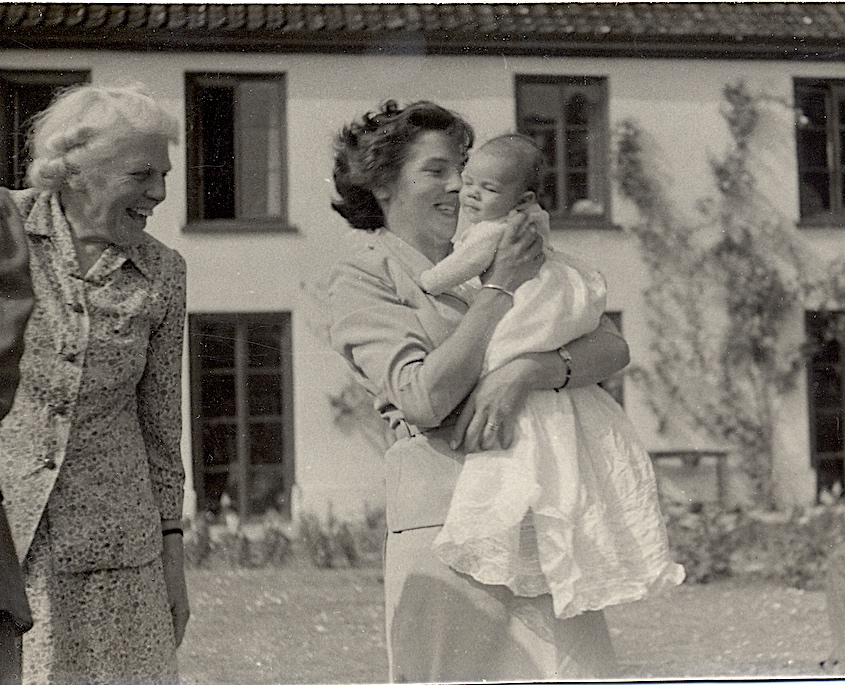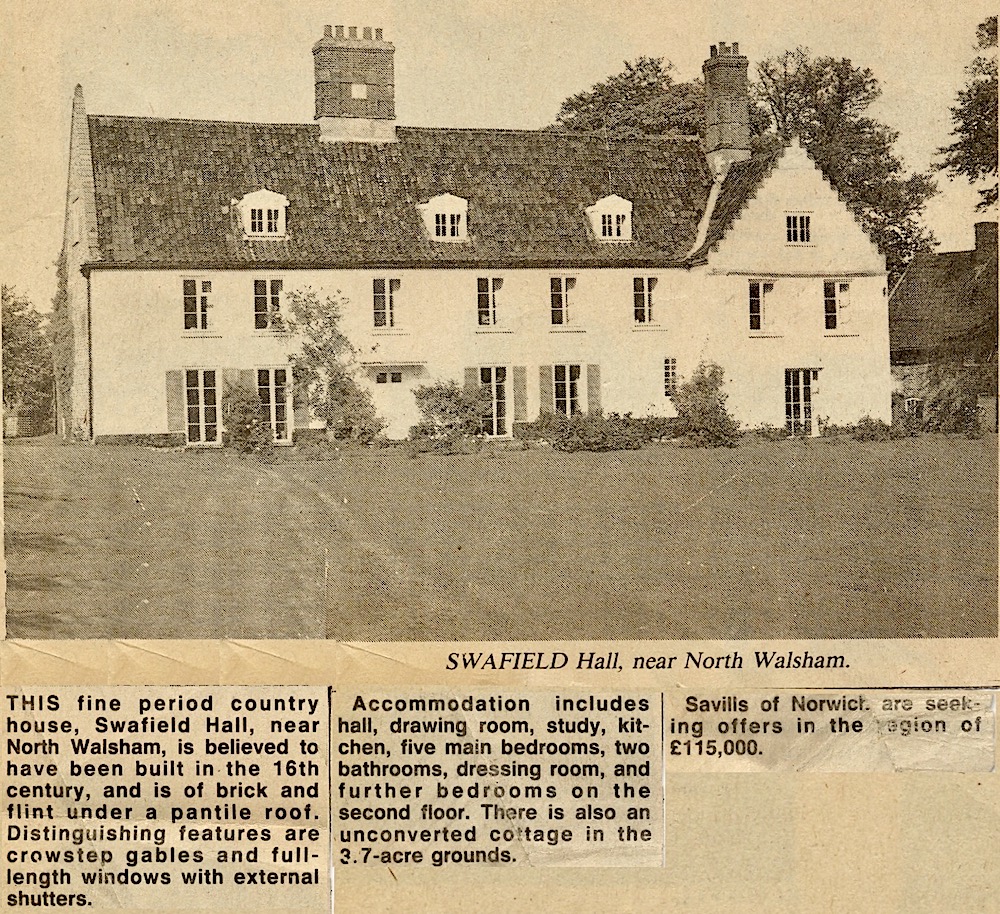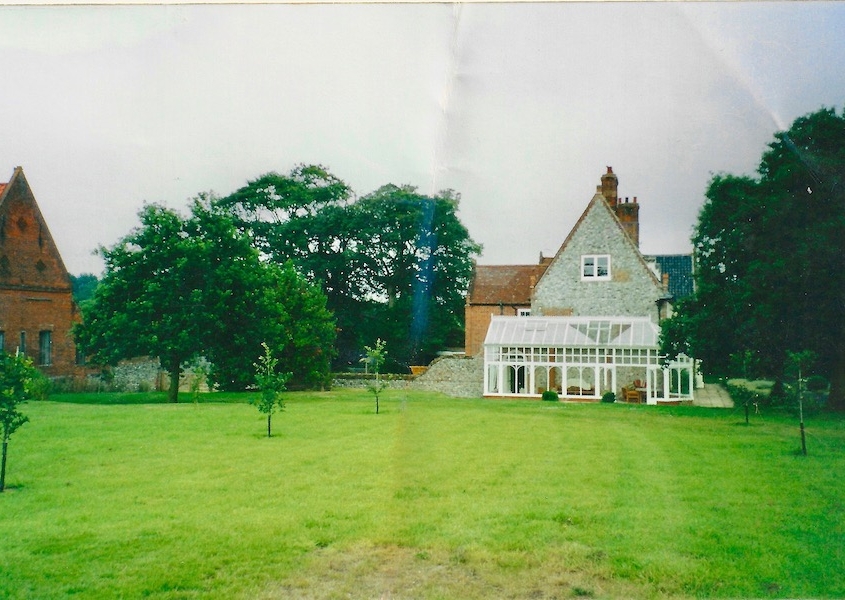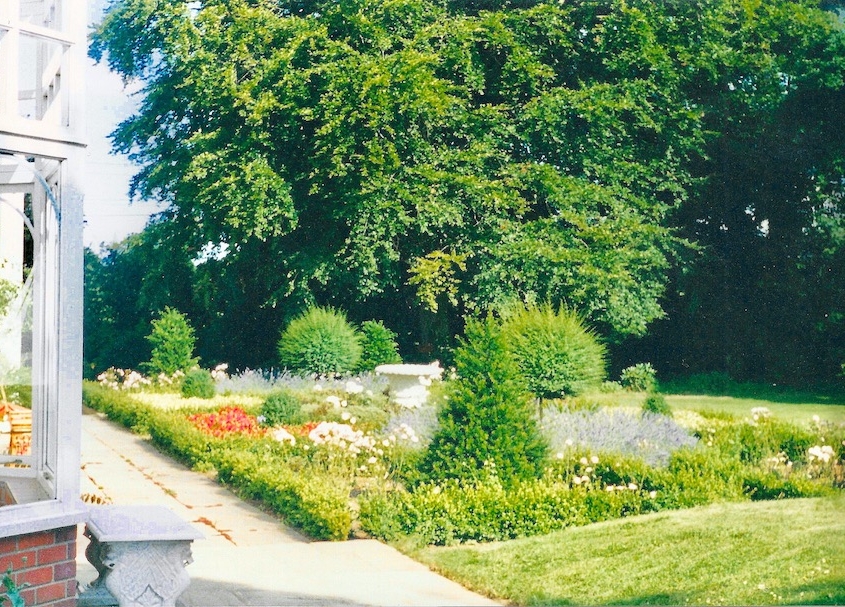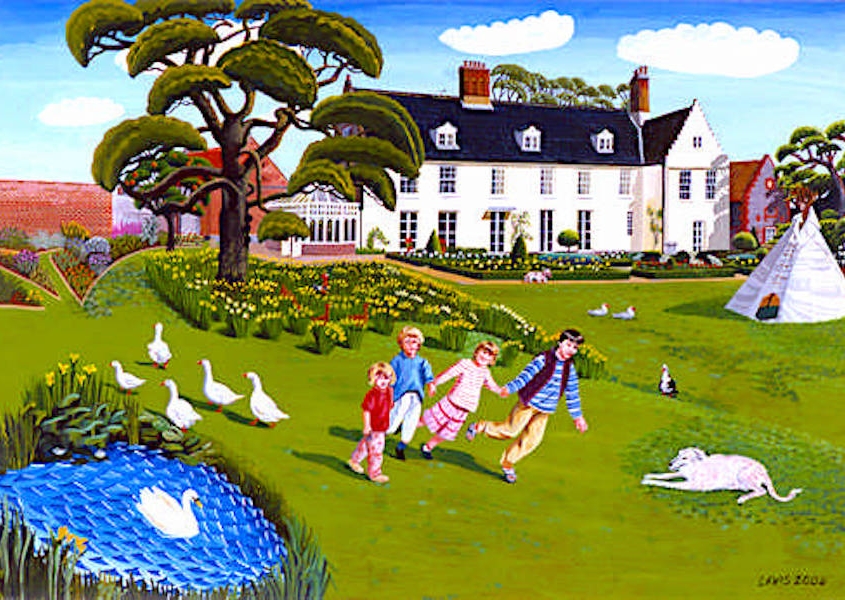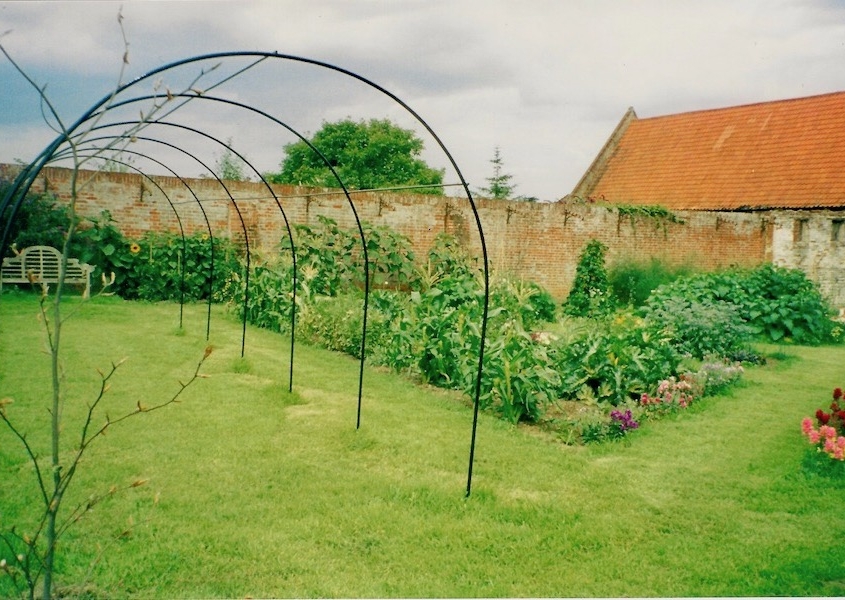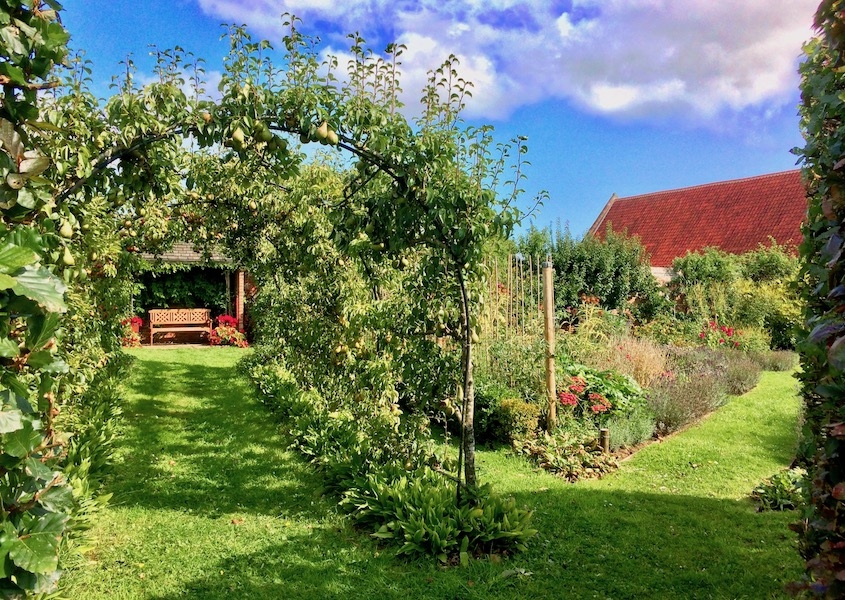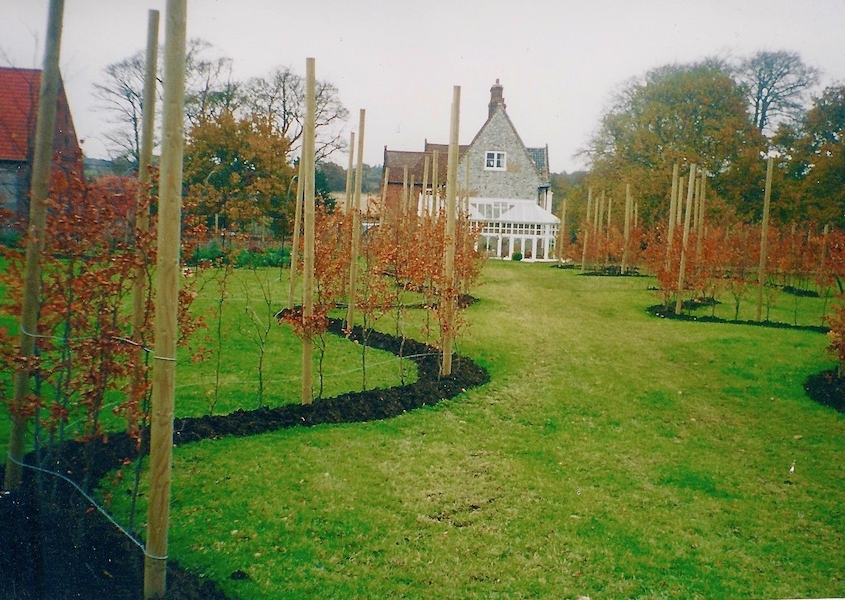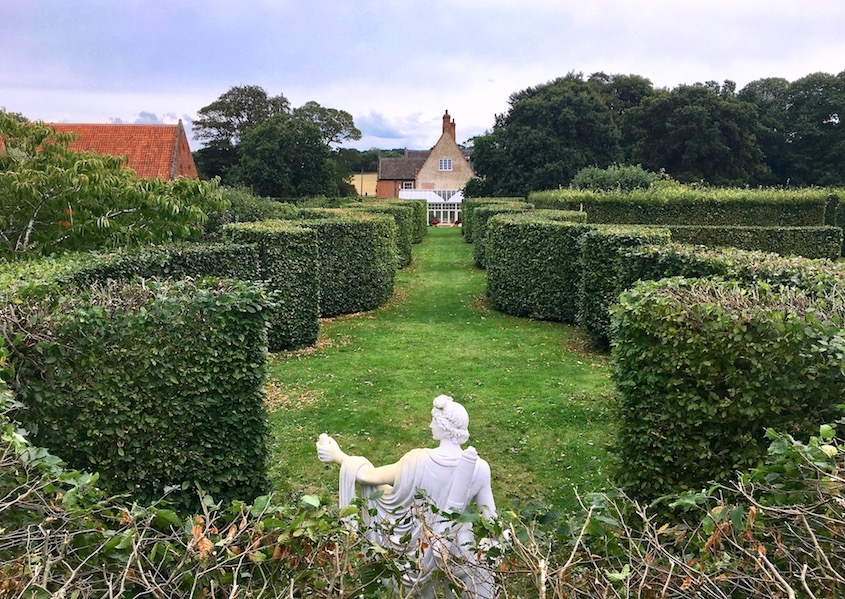History of Swafield Hall 1466 – 2014
Lime washed Georgian South elevation of Swafield Hall
The History of Swafield Hall can be traced back to May 1466, when it was mentioned in the will of William Burgey, who was lord of Swafield Hall at that time. It is especially remarkable that William Burgey stated that Swafield Hall, his only manor, was to be sold by his executors so that a priest might sing for his soul for seven years in the church of St Nicholas at Swafield, where he wished to be buried beside the grave of his wife Alice.
His will is singular enough to reveal a man of integrity as well as individuality. What William called his “messuage in Swafield” with all his other property there and in the surrounding area he left to James, his son and heir, but James also had to find a priest to sing in the church of St Nicholas – for three additional years. There was another son, Henry, and a married daughter Beatrice; they were only left sheep, as were a whole host of other folk. Sheep were a pretty good inheritance then: between the late thirteenth century and late fifteenth century wool was the driving force of the English economy. Many landowners, including lords, abbots and bishops, counted their wealth in terms of sheep. There was enormous demand for wool, and everyone who had land, from peasants to major landowners, raised sheep. Apparently William Burgey of Swafield Hall did too. The wealth from wool definitely poured in to the North Walsham area (especially to Worstead). Norfolk wool was best suited to heavier cloth, and so Norwich and Norfolk eventually gained almost a complete monopoly on worstead. Those profits fuelled an extraordinary ecclesiastical building boom, and at that time, in the 15th century, the nave of St. Nicholas of Swafield was rebuilt and enlarged. The new roof of the nave was built, with arched braces running straight up to the ridge through a 26 feet (8m) span – with no ties. Amazingly, this stunning roof has survived to this day.
Quite possible that all this 15th century renovation was done with the financial assistance of William Burgey of Swafield Hall, and this is why the small church of St. Nicholas in the little village of Swafield was so close to his heart. According to his will, twenty mark was to be spent on new tabernacles for the images of the Blessed Virgin and of St Nicholas in the church. The poor were kindly remembered: every pauper of Swafield and of five other adjacent townships was left a penny, and the thirteen poor men who were to attend William’s funeral at St Nicholas were to have gowns and food and drink. A hundred masses were to be celebrated for him by the four orders of friars (Dominicans, Franciscans, Augustinians, and Carmelites) at Norwich. William Burgey undoubtedly believed in the efficacy of prayer, the prayers of the poor in particular!
Tudor North facade of Swafield Hall with traditional Norfolk red brick and flint walls
The existing house was built in Elizabethan times, in the late 16th century. Swafield Hall was altered in the 17th and 19th centuries and as the result the house received two facades in different styles: a Tudor North facade with traditional Norfolk red brick and flint walls and a lime washed Georgian South elevation, with stunning French windows in the ground floor (not so common in Norfolk) and a black glazed pantiles roof.
Local legend reports that the history of Swafield Hall is connected to Admiral Nelson, who allegedly stayed there (he apparently visited the area many times), and some believe that the house is inhabited by a friendly ghost.
The house is mentioned in “The Buildings of England” by Nicolaus Pevsner and Bill Wilson.
Part of the map of Swafield dates back to 1839. St. Nicholas Church is on the left, Swafield Hall estate is on the right.
The history of Swafield Hall has always been closely related to St. Nicholas Church of Swafield. It is interesting that Swafield Hall was built in line with the church, so parishioners always sat facing the hall during the service. Like St. Nicholas Church, Swafield Hall is oriented parallel to the West-East axis.
Swafield Hall, its Grade II listed barn and the church of St Nicholas, which you can see across the field from the windows of the Hall, are a part of North Norfolks’ heritage.
St Nicholas church at Swafield dates from the late 15th century. The tower is from 14th century and the nave has a thatched roof
The history of Swafield Hall is full of interesting names and events.
In 1836 Swafield was described in the book “History, gazetteer, and directory, of Norfolk, and … the city of Norwich” by William White, as “a parish and small village, on the north side of the canal, between two sources of the river Ant, 1 ½mile N. of North Walsham”. It was mentioned that Swafield “has 155 inhabitants, and about 800 acres of land, belonging to a number of proprietors, some of whom have neat houses here”.
A retired army officer and a hero of the Peninsular War, Captain Robert Blake (1795 – 1886) was the owner of Swafield Hall estate at that time. Robert’s life story is amazing. He was born at Horstead in Norfolk and baptised in Norwich, his father was a barrister.
In 1813 at the age of 17 Robert Blake was an officer in the 3rd Regiment “The Buffs” and served in the Peninsular War under Wellington. At the passage of the Nive (November 13th) he was directed to take the command of a company of the 57th, all the officers of which had been wounded. While doing duty with this company, Robert Blake was exposed to severe fire of artillery and was badly wounded in both legs above the knee. His left leg had to be amputated. He wrote in his diary: “I had strength and good spirits to bear up through the operations with cheerfulness and without flinching. Dr. Shekelton paid me compliment saying “It was like operating on a dead body”. Again, he was just 17 years old.
After the war, Captain Robert Blake returned to London. He received a good pension and in 1814 moved back to Norwich to join his brothers and sisters, who lived in the family’s old residence in Queen street. In 1835 Robert with his sister Judith moved to his own Swafield Hall.
An article about Swafield from the book “History, gazetteer, and directory, of Norfolk, and … the city of Norwich”, 1836.
Heggatt Hall at Horstead, where Robert Blake was born. Watercolour by Robert Blake, 1832
Robert Blake. Portrait by Frederick Howes, 1853
Charlotte Blake (Harvey), Robert’s wife. Portrait by Frederick Howes, 1853
In August 1838 at the age of 42 Robert Blake married Charlotte, the daughter of Colonel Harvey of Thorpe St Andrew (she was 29 years old) and in November, after a honeymoon trip to France, Belgium, Holland, Germany and Switzerland, they took up their “abode at Swafield”.
Marriage certificate of Robert Blake (Swafield) and Charlotte Stephens (Thorpe St Andrew)
Charlotte and Robert occupied the Hall with its courtyard, garden, lawn and park. The arable land of Swafield Hall estate was leased to a farmer John Warnes.
On the picture: A fragment of a Map of the parish of Swafield (1839) showing the Swafield Hall Estate when Captain Robert Blake lived there.
Purple line – land owned and occupied by Captain Robert Blake: 127 – Homestead (Swafield Hall) & Garden, 128 – Lawn, 198 – Plantation/Park
Green line – arable land owned by Robert Blake but occupied by John Warnes: 120 – Bolts Close, 121 – Middle Bolt Close, 122 – Upper Bolts Close, 123 – Lady’s Pightle, 124 – Dove House Close, 125 – Upper Dove House Close, 126 – Dove House Pightle
Blue line – Land belonging to the “Charity for the relief of Widows and Orphans of Clergymen”.
Captain Robert Blake lived in Swafield Hall with his family until August 1847. Five of his seven children were born there (Margaret b. 1841, Robert b. 1843, Tomas b. 1844, Eleanor b. 1846 and John b. 1847).
A gifted watercolorist, he depicted Swafield Hall with his family on the Main Lawn, and this watercolour is filled with quiet rural happiness and peace.
Watercolour of Swafield Hall by Robert Blake, with his sister Judith, wife Charlotte and children on the Main Lawn: 6-year-old Margaret, 4-year-old Robert (on the horse), 3-year-old Tomas (walking) and one-year old Eleanor -1847.
Cover of the first volume and some inner pages of the book “Sheriffs of Norfolk”, created by Captain Robert Blake
In 1847 a major turn took place in Robert Blake’s life, when he even had to change his name. His wife’s relative Rev John Humfrey A.M. died in June 1847 aged 82, and Robert inherited from him Wroxham House. Leaving no issue, Rev John Humfrey bequeathed his mansion in the parish of Wroxham and all his estates in Norfolk, Suffolk, &c. to Robert Blake of Swafield, by his will requesting him “to take the name of Humfrey after and in addition to his own, and bear the arms of Humfrey quarterly with those of Blake”.
Robert Blake moved from Swafield Hall to Wroxham House and did indeed add the name of Humfrey to his own and accepted the arms of Humfrey.
Wroxham House was altered in 1848 and 1849. Robert remained on the electoral role in Swafield until 1849, even though he spent a lot of time in Wroxham. Swafield Hall was empty for almost 8 years, but in 1857 the estate was finally sold to a new owner.
On the right: Stained glass window with the heraldic arms of Robert Blake Humfrey (left) and wife Charlotte Harvey (right) in the Church of St Mary, Wroxham, Norfolk
Wroxham House, owned by Captain Robert Blake-Humfrey – a large Georgian mansion that used to be one of the most significant buildings in Wroxham.
The youngest daughter of Robert Blake-Humphrey, a well known English philanthropist Isabel Charlotte – Baroness Talbot de Malahide (1851 – 1932) was born at Wroxham House. In 1871 she married John Gurney (1845–1887), a wealthy Norwich banker from the Gurney family of Earlham Hall, connected to many social reformers. John Gurney and Isabel had seven children. Like her father, Isabel was a talented artist in both watercolour and oils, her paintings and those of Robert Blake-Humphrey are still owned by the Gurney family. Isabel and her husband were deeply involved in many educational and philanthropic projects in Norwich, including the conversion of Norwich Castle into the city museum. He was a Justice of the Peace and the mayor of Norwich. On retiring from the position of mayor in 1886, Gurney’s health was failing. He died the following year, aged 41. In 1901 Isabel married Richard Wogan Talbot, 5th Baron Talbot de Malahide (1846–1921) and moved to his home at Malahide Castle, County Dublin, where she continued her philanthropic work.
In C20 Wroxham House was the main residence of the Charles family. In 1950, when Col Stephen Flockton Charles died, the land had been sold, and in 1954 the house was demolished. By 25 March 1961 new houses were built with the show home at 65 Charles Close.
In 1857 Tomas Dolphin (1811-1866) bought Swafield Hall from Captain Robert Blake-Humfrey and moved there with his family. After that Thomas proudly called himself “Thomas Dolphin of Swafield Hall”. But what kind of person was he?
His father John Dolphin (1774 – 1830) was a rector for two village churches near Colchester in Essex. He died in 1830 (Thomas was 19 years old). After that Thomas’s older brother John Dolphin (1804 – 1889), educated at Eton, was appointed as Vicar of Antingham and Thorpe Market in Norfolk.
So, in 1830 John, Thomas and their mother Martha Dolphin (1782 – 1864) moved from Essex to Norfolk.
Thomas’s parents could not give him the same good education as his elder brother John, so in Norfolk Thomas began to build his fortune working as a farmer, renting land in Swafield.
St. Mary’s church in Antingham
John Dolphin (Thomas’s brother) was the vicar of Antingham and Thorpe Market for 59 years and lived in Antingham Rectory.
There is a memorial window in St. Mary’s church in Antingham, dedicated to Martha Dolphin, erected in 1868 by her relatives. The Dolphins seem to have been people of taste, because the windows were commissioned from the rising firm of William Morris, Marshall, Faulkner & co. The cartoon for St Mary Magdalene is by William Morris himself. She carries an alabaster box of ointment. The long flowing red hair so loved by the Pre -Raphaelites represents the fact that she dried Christ’s feet with her hair. The figure of the Virgin Mary, carrying lilies (the symbol of purity) represents the annunciation and was designed by Edward Burne Jones. The figure of St Martha, sister of Lazarus & Mary is carrying a pitcher of wine, spoons & pans to enable her to provide refreshment for Christ. The window was designed by Rosetti.
Another window was erected in St. Mary’s church in Antingham in 1891 to the Rev. John Dolphin B.A. It was produced by Chas E Kempe . The main lights depict : St Peter (carrying a key), St John (carrying a poisoned chalice) and St James (carrying a scallop shell attached to his staff)
Memorial window in St. Mary’s church in Antingham to Martha Dolphin (St Mary Magdalene, Blessed Virgin, St Martha )
Memorial window in St. Mary’s church in Antingham to the Rev. John Dolphin B.A. (St Peter, St John , St James).
But let’s return to 1836. In the book “History, gazetteer, and directory, of Norfolk, and … the city of Norwich” we can see that Dolphin Mr & Mrs (Thomas Dolphin and his mother Martha) lived in Swafield. In 1839, according to the map of Swafield, Martha was a tenant, occupying a Georgian house known as “The Old House”, and Thomas as an occupant farming quite a lot of arable land, attached to The Old House.
A fragment of a Map of the parish of Swafield (1839).
Purple and Green lines – Swafield Hall Estate. Red line – land occupied by Thomas Dolphin. Blue line – land owned by “Charity for the relief of Widows and Orphans of Clergymen” (about 200 acres).
In the Census of 1841, 30-year-old Thomas Dolphin was mentioned as a farmer (living in Swafield in the Street). Ten years later, in the Census of 1851, Thomas Dolphin’s “Rank, Profession or Occupation” was described already as a “Land Proprietor”, who lived as a tenant in Swafield House with two servants.
So, Thomas Dolphin was a real self-made man. In 1853 in Henley, Thomas married Charlotte, daughter of the late John Stephens, Esc., of Caversham Rise, Oxford. He was 42 years old and Charlotte – 28.
On the picture: A fragment of 1841 census, Swafield. Thomas Dolphin is mentioned as a farmer.
A fragment of 1851 census, Swafield. Thomas Dolphin’s Rank, Profession or Occupation – “Land Proprietor”
For the first 4 years of their marriage the Dolphins lived in the village in a rented home. But in 1857 the family finally moved to their own place – to Swafield Hall. Thomas Dolphin was appointed by the Crown to act as a magistrate – become a J.P.
He spent only 9 years living in his first own home. Thomas died in 1866 at the age of 55. But in the history of Swafield Hall his family held the honourable position as the owners of the hall for 90 years: they lived at Swafield Hall until 1947.
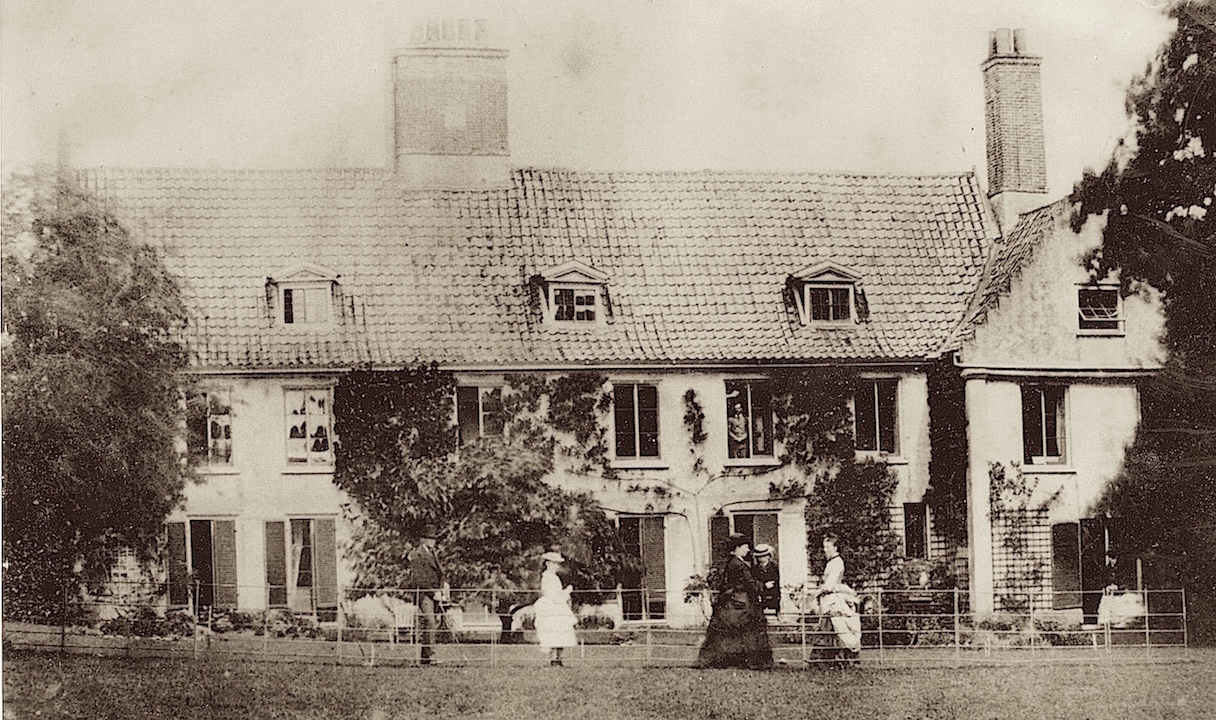
South elevation of Swafield Hall, circa 1880. The Dolphin family in front of the house: Charlotte Dolphin (1825 – 1917) in a black dress, and her children Thomas William (1853 – 1924), Katharine Ellen (1855 – 1932), Henry (1856 – 1881), Edgar (1857 – 1889), Martha Frederica (1864 – 1952).
Life wasn’t easy for Mrs Dolphin of Swafield Hall. When her husband Thomas Dolphin died, Charlotte’s youngest daughter Martha Frederica was just 2 years old. Three years later her eldest son Thomas William (1853 – 1924) at the age of 15 left the family home. Thomas was educated at Haileybury, at Exeter College, Oxford, and the Chancellor’s School at Lincoln, and was made Deacon in 1879, and ordained Priest in 1881 by the Bishop of Lincoln. For most of his life Rev Tomas William was vicar of Carlton-in-Moorland, Lincolnshire. The book ‘Norfolk Leaders Social and Political’, published by Queenhithe, London, 1907, mentioned that “Rev. T.W. Dolphin attracts all classes by his work, and has, by his tact, courtesy, liberality and consistence, a moral influence over rich and poor”. The book names Thomas William as “the oldest and only surviving son” of the late Thomas Dolphin, Esq., J.P., of Swafield Hall.
Norfolk Leaders Social and Political – a book by Ernest Gaskell, С1907.
Rev. Thomas William Dolphin (1853 – 1924), picture from the book Norfolk Leaders Social and Political, C1907.
Thomas’s brother, Captain Edgar Dolphin (1857 – 1889), with his dog at Swafield Hall.
Thomas’s two younger brothers, Henry and Edgar, joined the army.
In January 1881 Henry was killed at the Battle of Laing’s Nek during the First Boer War in South Africa. The British lost 84, most of the casualties were in the 58th Regiment. Henry was only 24 years old.
Charlotte’s third son Edgar served as a captain of the 2nd Battalion, King’s Own Royal Regiment, in South Africa, India and Pakistan. In September 1889 Edgar, who was on leave of absence and was staying at Swafield Hall, accidentally drowned in Norfolk, on Wroxham Broads, at the age of 32.
Memorial to Captain Edgar Dolphin, Second Battalion the Kings Own Royal Lancaster Regiment, erected by his brother officers in Lancaster Priory (St Mary Churchyard), 1889
Charlotte Dolphin with her dog at the Bacton Wood lock of North Walsham & Dilham Canal.
St Nicholas Church of Swafield, 1898.
Interior of St Nicholas Church of Swafield, 1898.
Rev Frederic Simpson Thew, rector of St.Nicholas 1886 – 1922
Charlotte become a church warden at St. Nicholas. She donated money to build a magnificent Victorian stained-glass window of the chancel on the south side, above the choir stalls, where her sons had sung as choir boys. The glass was made in 1904 by Jones & Willis, one of the biggest firms in the latter part of C19 who manufactured church furnishing and stained glass. There is Jesus Christ the shepherd in the middle of the window, on the left – St. Cecilia, the patroness of musicians, with a portable organ, and on the right – St. Nicholas with his symbol of three golden balls (late used by pawnbrokers!).
Charlotte Dolphin lived in Swafield Hall for 60 years and died in 1917 at the age of 92. She was buried beside her husband Thomas next to the entrance porch to Swafield church.
The grave of Thomas Dolphin (1811-1866) and Charlotte Dolphin (1825 – 1917) at the entrance to St. Nicholas church, Swafield
Stained glass window in the church of St. Nicholas in Swafield
Written in the bottom of the window: “For the glory of God and in loving memory of Henry Dolphin who was killed at Laing’s Nek in Jan 28 1891 & Edgar Dolphin accidentally drowned Sept 21 1889 This window is erected by their Mother”.
Charlotte Dolphin (1825 – 1917), who was the mistress of Swafield Hall for 60 years, from 1857 until 1917.
Charlotte’s youngest daughter Martha Frederica (1864 – 1952), known as Freda. She was born at Swafield Hall and owned it until 1947.
Violet Beryl Packard (1886 – 1975), known as Beryl, and James Ernest Edgar Packard (1890 – 1954) – Freda’s children who were brought up at Swafield Hall.
Charlotte’s oldest daughter Katharine Ellen Dolphin (1855 – 1932) lived with her mother at Swafield Hall and was responsible for teaching village children at the Sunday School in the Village School building (now the Village Hall).
The youngest daughter, Martha Frederica (1864 – 1952), known as Freda, was married to John Harrison Packard (1859 -1910?) on 8th August 1885 at St-Nicholas church in Swafield by her uncle the Rev John Dolphin, the vicar of Antingham. John Packard worked abroad, so Freda traveled a lot. Their first daughter, Violet Beryl Packard (1886 – 1975), known as Beryl, was born in Middlesex, son James Ernest Edgar Packard (1890 – 1954) – in Germany.
In the 1890s John Harrison Packard was in Lower California Mexico. Freda traveled across the ocean to be with her husband. She made the journey at least three times, from Swafield Hall to America and back to Norfolk. Most of the journeys were with her two very young children Beryl and James, but not her husband John, who continued to work in Mexico.
The legendary Hotel Iturbide in Ensenada, Lower California, Mexico. Photo taken in the luxurious years of the Hotel, from a book “Baja California Ilustrada”, 1899. Freda Packard stayed there during first visits to her husband John Packard, who was a general manager.The Hotel was built in 1887 of wood, with three floors, spacious galleries, a gym for guests, and magnificent views of the bay. It was considered to be equal to the best hotels on the Pacific coast. The hotel was completely destroyed by fire in 1904.
In 1898 John Harrison was appointed as general manager of the English Mexican Land and Colonisation Company, developing Ensenada in Lower California Mexico. Packard’s third child Mary Carmen was born there in July 1898. She was named after the wife of Porfirio Diaz who was the President of Mexico at that time and John Harrison Packard knew him very well. Porfirio Diaz has been characterised as a “republican monarch”, his 31-year-long regime – as “a synthesis of pragmatic [colonial-era] Bourbon methods and Liberal republican ideals”.
There were demonstrations in Ensenada in which the English Mexican Land and Colonisation Company was accused of discrimination against Mexicans in the access to land being colonised. In fact, a petition with 600 signatures for the removal of Packard as manager was filed. At the same time, the Hotel Iturbide (built in 1887 of wood, with three floors and magnificent views of the bay), once a prosperous business for the company, was operating at loss. In 1904 the hotel was completely destroyed by fire. John Harrison Packard had to resign in 1905 and focused on farming and ranching.
He was trying to find new areas for his business and advertised his services extensively in 1907 in the magazine “Out West” describing himself as a “Banker and Broker, Ensenada Lower California Mexico”.
The last time Freda traveled from Liverpool via USA to Ensenada Mexico to see her husband was in 1907. She returned back to England in April 1908.
At the end of the first decade of the 20th century the 31-year-long regime of president Porfirio Díaz in Mexico was close to failure. All attempts at developing Ensenada, made by the English Mexican Land and Colonisation Company, were interrupted by the Mexican Revolution, which left the area devastated. John Harrison Packard died at that time and was buried in Mexico.
Ads published by John Harrison Packard in “Out West” magazine, January 1907
But let’s get back to the history of Swafield Hall. After returning to England in 1908, Freda Packard and her daughters lived at the Hall, although Freda still traveled a lot. At the Hall Freda’s eldest daughter Beryl (1886 – 1975), sister Katharine Ellen Dolphin (1855 – 1932) and mother Charlotte were looking after young Mary Carmen Packard, known as Carmen (1898 – 1980).
85-year-old Charlotte Dolphin, in front of Swafield Hall’s sunny South facade, sheltered in the corner close to the pantry window. Circa 1910.
South Facade of Swafield Hall, with a tennis court in front of the large magnolia tree and rose garden, Circa 1910. The corner where Charlotte Dolphin liked to sit in her chair is on the right, next to a trellis.
Mary Carmen Packard, known as Carmen (1898 – 1980) – grand daughter of Charlotte Dolphin, Circa 1910.
Violet Beryl Packard (1886 – 1975), known as Beryl – grand daughter of Charlotte Dolphin, Circa 1910
The programme of Café Chantant in the Town Hall in Cromer, 10th December 1908, where Beryl was in a play.
At the beginning of the 20th century, the life of the owners of Swafield Hall wasn’t boring at all. At the time, only ladies lived there, and the young generation of the hall, together with the Dolphins from Antingham and the Packards from Sheringham participated in social events such as Café Chantant in the Town Hall in Cromer. One of them was organised in December 1908 to support F. Company, 5th Batt. Norfolk Regiment (home force made up of volunteers in Cromer). Beryl Packard played the role of Princess Elizabeth Stuart in a little play “The King Shall Have His Own Again” and received “a handsome bouquet”. Emma C. Dolphin and Helen Joy Dolphin took part in a “vivacious little duologue Lady Kitty’s Temptation”, written by Miss Alice Packard – as Lady Kitty Cartaret (a young widow) and Miss Evelyn Bailey, masquerading as her maid. The event was described in a local newspaper as highly successful.
The programme of Café Chantant in the Town Hall in Cromer, 10th December 1908, where Beryl Packard played the role of Princess Elizabeth Stuart in a little play “The King Shall Have His Own Again”.
A page from Beryl’s album with a clipping of an article about Cafe Chantant in Cromer, and a dried flower from a bouquet given to her.
Every August the Rectory Bazaar was traditionally held in Swafield, and in the 1910 bazaar 12-year-old Carmen “had control of the cake competition, and make it a complete success”. Freda, Katharine and Beryl organised the event, Beryl also took part in a pastoral play there, which “was a real success, and tickets in large numbers were sold to willing patrons, who enjoyed a great treat”. The report stated that “There was no hitch, and scarcely a dull moment. Moreover, we aimed at taking £40, and we took about £67. Well done, Swafield!” £67 in 1910 is equivalent in purchasing power of about £8,800 today!
A page from Beryl’s album about Swafield Rectory Bazaar, 17th August 1910, with a clipping of an article about an event.
The programme of Swafield Rectory Bazaar, 17th August 1910.
Every Christmas there was a party at Swafield Hall for the village children, organised by Katharine Ellen Dolphin, and “there was an enormous Christmas Tree standing in the middle with a gift for each child”. Katharine wasn’t married and looked after Swafield Hall all her adult life. She was also teaching village children at the Sunday School in the Village School building (now the Village Hall).
Swafield Village, the Street in 1908. The Village School building is on the right. Katharine Dolphin was teaching village children at the Sunday School there. It was originally a Church of England school opened in 1852. There were probably about 60 children there. Like many such schools it was closed in 1930.
In 1911, according to the census, seven women lived in the 17 rooms of Swafield Hall. There were 3 ladies: 86-year-old Charlotte Dolphin, 56-year-old Katherine Ellen Dolphin and 13-year-old Mary Carmen Packard; 4 female servants lived with them: a 55 year old cook, 45 year old house parlourmaid, 14 year old housemaid, and an elderly 73 year old nurse. Freda, 47, stayed with her 67-year-old aunt Cecilia Mary Stephens in Chawton, Hampshire, and 25-year-old Beryl Packard was visiting her friend Janet Hunt’s family in Surrey. Here, in Surrey, Beryl met her future husband Bill, a successful army officer, but they could only marry after the war, in 1919.
Charlotte Dolphin died in 1917. Katherine Ellen Dolphin become the new mistress of Swafield Hall, along with her sister Freda Packard. Four years later, according to the 1921 census, only Katherine Ellen Dolphin permanently lived in the Hall, with two female servants: a 28-year-old cook Hannah Newstead and a 26-year-old house made Lucy Gedge. Martha Frederica was in London at St George’s Hanover Square, James Edgar Packard served in Germany. But Martha Frederica spent quite a lot of time at Swafield Hall, she was on Electoral Registers in Swafield from 1919 until 1931. And these years were full of happy events.
In 1919 Beryl Packard married General William Alan Blake (1878 – 1959) from Surrey, and left Swafield Hall. The marriage was registered in Smallburgh (7 miles from Swafield). William Alan Blake served on the Staff, 1914-18, in the European War. He was mentioned in Despatches, and was created a Companion of the Distinguished Service Order (London Gazette, 23 June, 1915: “W.A. Blake, Major, Wiltshire Regt. For distinguished service in the field”). He was Temporary Lieutenant-Colonel from June 1915, and subsequently became Brigadier-General. In 1918 he was created a C.M.G.
Beryl’s first daughter Particia was born in 1920 in Alexandria, her second daughter Rosemary – in 1922 in Elderton Lodge, Erpingham, Norfolk.
William Alan Blake (photo by Lafayette), 5 July 1930. NPGx70492. Given by Pinewood Studios via Victoria and Albert Museum, 1989.
Freda’s son James Ernest Edgar Packard (1890 – 1954) followed in the footsteps of captain Edgar Dolphin, his uncle. He went to the Royal Military College and in 1910 was appointed second Lieutenant in the Kings Own Royal Lancaster regiment, the same 2nd battalion. By 1911 he was serving as a Lieutenant in the Fort Regent, Channel Islands and in 1915 he was appointed captain. James Ernest Edgar spent a lot of time in China and India.
An interesting picture can be found in the museum of the King’s Own Royal Regiment (Lancaster):
“The wedding of Captain James Ernest Edgar Packard, the son of Mrs Packard of Swafield Hall, Norfolk, to Miss Joan Worship, daughter of Hugh Worship, the well known former Ceylon Planter, of Earsham Lodge, Suffolk. January 1925”.
James Packard (MC, an officer of the King’s Own Royal Regiment) was at the time an instructor at the staff college in Quetta, India. The bridesmaid at his wedding was Miss Mary Carmen Packard, the groom’s sister, also from Swafield Hall.
James Ernest introduced to Mary Carmen his army colleague Vivian Leslie De Cordova (1899 – 1967), who was a Captain in the same regiment, the Kings Own Royal Regiment.
The wedding of Captain James Ernest Edgar Packard, the son of Mrs Packard of Swafield Hall, Norfolk, to Miss Joan Worship. January 1925.
On the 6th July 1926 Mary Carmen and Vivian Leslie were married at St Nicholas church in Swafield. The celebration took place at Swafield Hall. James Ernest Edgar Packard with his wife Joan, Freda Packard and Katharine Ellen Dolphin were there. Mary Carmen and Vivian Leslie had two children. As Commanding Officer, Lieutenant Colonel Vivian Leslie de Cordova MC from 1937 to 1940 was serving in India, in the 1st Battalion, King’s Own Royal Regiment. Mary Carmen and her daughter Ann stayed at that time with Beryl at Elderton Lodge.
The Dolphins were owners of Swafield Hall for 90 years. From 1920 to 1947 Swafield Hall belonged to Martha Frederica Packard, her brother Thomas William Dolphin (1855-1924), who lived in Lincolnshire, her cousin from Surrey Lieutenant Colonel Harry Edmund Dolphin (1842 – 1924), and sister Katharine Ellen Dolphin. Martha Frederica was on Electoral Registers in Swafield from 1919 until 1931, her son James Ernest Edgar Packard – in 1930 and 1931. In the early 1930s, they looked after Katherine Ellen. She died in 1932, and since then no one from the Dolphin/Packard family has lived permanently in the hall.
Before World War II, the empty Swafield Hall began to fall into disrepair, like many manor houses in England at that time.
Mary Carmen and Leslie De Cordova on the day of their wedding at Swafield Hall, July 1926
During World War II, the history of Swafield Hall again became associated with the army. The 4th Battalion of Oxfordshire and Buckinghamshire Light Infantry was located there. The battalion acted in a training capacity, sending drafts of replacements overseas. In 1943 the battalion had sent 46 officers and 1,524 other ranks as replacements. Servicemen of the battalion took care of the hall, built a new sewer system with a new septic tank, repaired rotten windows, replaced broken glass.
The 4th Battalion stayed at Swafield Hall until the end of 1946. During the renovation of 2015-2018 the current owners found under the floor-boards army uniform buttons, cigarette boxes and old glass medicine bottles from that time.
Officers and Non-commissioned officers (N.C.O.s) – staff of the 4th Battalion of Oxfordshire and Buckinghamshire Light Infantry at Swafield Hall, Norfolk, 1944
In September 1947 Swafield Hall was sold by auction through Harrods (London) and W. Vincent & sons (Norwich). The catalogue from that auction with all Swafield Hall particulars can be seen at the bottom of the page. Five years later Martha Frederica Packard died at Saxlingham Hall Nursing Home, Norfolk, leaving effects valued at £5,661 to her three children and legacies to three grandchildren.
The new owners came to Swafield Hall after the auction in 1947 – the Barratt family.
Swafield Hall in 1947, with a large magnolia tree and rose garden in front of South facade.
Swafield Hall in 1947: herbaceous border and walkway to St. Nicholas Church.
The new master of Swafield Hall Mr James Stanley Knevett Barratt (1885 – 1955) earned his fortune in the 1930’s and 1940’s managing shipping business between America and England. In late 1930’s he moved with his family from Manchester to Norfolk sea cost area. In 1939 they lived in Cromer. In 1947 James Barratt bought Swafield Hall for his big family with tree sons and two daughters. His sons received agricultural education. Peter lived separately in Bedfordshire but Brian (1926 – 2005) and Desmond (1921 – 2013) wanted to do farming at parent’s estate.
Barratt family in the Drawing room at Swafield Hall, 1953.
Bottom line from right: Julia Lyndel Flint (now Richards), Betty Robinson (maiden name Barratt) and her daughter Susan, Eva Grace Barratt (1890 – 1975), her husband and master of Swafield Hall James Stanley Knevett Barratt (1885 – 1955), Andrew Barratt, Daphne Flint (maiden name Barratt), Tina Flint. Top line: Angela Flint, Peter Lockwood Barratt, his son David, Brian Knevett Barratt (1926 – 2005), Desmond Bridgeman Barratt (1921 – 2013), Arthur Flint, Mr Robinson, Sylvia Barratt (Peter’s wife), Philippa Flint.
James Barratt spent only 8 happy years living with his wife Eva in Swafield Hall. For her James made “a dell”- a tiny valley in a wooded area of Swafield Hall estate, tucked away from the rest of civilisation, starting up near the Morning room and ending in the forest meadow. Around this romantic forest path James put a lot of snowdrops, daffodils, hyacinths, blue bells, primulas and cyclamens. Even now you can see this flowers coming every spring.
James Barratt became a warden of St Nicholas Church and joined Swafield parish council. He contributed a lot to village life, and after his death in 1955 the commemorative plaque dedicated to him was placed inside the new bus stop in Swafield.
In 1955 Swafield Hall received Grade II listed status. For centuries Swafield Hall hosted village fairs and other events, and the Barratt family continued this tradition.
Each year Swafield Village fete was held in the grounds of Swafield Hall (early 1950s pictures).
The large Barratt family lived happily in Swafield Hall for 27 years. They were proud owners of the Hall, and collected many documents, legends and photographs related to the history of Swafield Hall. Eva’s and James’s grand children remember fun family gathering, festive Christmas celebrations with wonderful presents and a lot of games around the house.
Barrat family Christmas party at Swafield Hall, in the Drawing Room. 1950’s.
Eva Grace Barratt (1890 – 1975) in front of the Hall with her daughter Betty and grandson James. 1950’s
In 1974 the Barratts sold Swafield Hall, because the old mansion became increasingly expensive to maintain. It was a difficult change for Eva Grace Barratt. She moved to the Muse (a converted old coach house which used to be a part of Swafield Hall estate) and died one year later after selling the Hall. Her and James Barratt grave is on St. Nicholas church yard, next to Thomas and Charlotte Dolphin’s greave stone.
The Barratts could not imagine a life away from their favourite Swafield Hall estate. Eva’s sons Desmond, Brian and his wife Elizabeth built a new small “Park house”, (which slightly resembled some aspects of Swafield Hall) on the land next door where Swafield Hall Park used to be. Elizabeth was a church warden at St Nicholas. They lived together and they rest in peace together in the north part of St. Nicholas churchyard.
The Park house was completely demolished by the owners in 2016.
Retired diplomat John Gabriel Tahourdin (1913-2007) in 1974 become the new owner of Swafield Hall after the Barratts. In the 60’s John Tahourdin was British ambassador to Senegal, Mauritania, Mali and Guinea, in the 70’s – to Bolivia, he travelled assiduously throughout West Africa and South America and earned much respect. He finished his career in the British Embassy in 1973 and in 1974 moved to North Norfolk with his wife Margaret Michie (married in 1957), his son and daughter.
An article in newspaper, advertising Swafield Hall for sale in 1974.
Perhaps rural Norfolk after Africa and South America was too calm for John Tahourdin. He lived separately from community life, and the tradition of holding village fairs at Swafield Hall ceased. Educated at St. John’s College in Oxford, John Tahourdin always wanted to return to the land of his jolly student youth, and at the age of 71 he downsized – sold Swafield Hall and started another chapter of his life in Oxfordshire.
In 1984 Brian Victor De Savoie-Carignan De Soissons (1929–2009) bought the estate from John Tahourdin. Brian moved here from London with his wife Daphne Evelyn (they married in 1955 and had 6 children).
Brian’s father Louis Emanuel Jean Guy de Savoie-Carignan de Soissons was the well-known London architect, the younger son of Charles, the Count de Soissons.
The De Soissons family had connections to Norfolk for over 100 years. Brian’s sister Jeanne (married capt. Arthur Neville Rolfe) lived not far from Kings Lynn at Heacham Hall estate, the Rolfe family home. Heacham was very popular as a seaside resort, and during the 1960’s – 70’s the de Soissons enjoyed many summer holydays at the West Norfolk coast. At the age of 55 Brian sold his house in Notting Hill, London, and moved with his family to Swafield near North Walsham. Swafield Hall is 50 miles East of the Heacham Hall estate, but De Soissons fell in love with the beautiful old house, the impressive history of Swafield Hall, its location and the tranquil sandy beaches nearby.
Swafield Hall estate at the time when De Soissons family lived there.
Brian de Soissons lived at the hall until 1999. Swafield villagers remember Brian as a very warm and friendly person. His wife Daphne passed away in 1995, their children grew up and lived separately, and in the late 1990’s Brian moved to Norwich.
His eldest son, real estate specialist Louis Thomas de Soissons with his wife Anna and three sons moved to his father’s country estate and developed the property.
The interiors of Swafield Hall were redecorated, and in front of the South elevation de Soissons created a box framed parterre, which was put in place by Norfolk garden designer Martin Perry.
Brian de Soissons died in 2009 in Norwich, but according to his wishes, he was buried at St. Nicholas Church of Swafield next to his wife Daphne. From that place on the church hill you can see beautiful fields and their favorite Swafield Hall.
Parterre at the South facade of Swafield Hall, 2003
In 2002 the estate was sold to John Charles Augustus David Buchan of Auchmacoy (b. 1963) and his wife Sharon J Buchan (married in 1998).
As Buchan clan chief Charles Buchan is a member of the Standing Committee of Scottish Chiefs. The Buchan’s family history and its connections with Auchmacoy in Aberdeenshire go back to the 15th century. Although Charles Buchan spent most of his time in the south, he is an avid supporter of the clan and a defiantly loyal Scot. His family has a fascinating genealogy. His grand mother, Lady Olivia Buchan, was the eldest daughter of the 18th Earl of Caithness. Lord Caithness, born Sinclair, took the surname of Buchan in 1911, after inheriting the Auchmacoy estate from his cousin, Louisa Buchan, 15th of Auchmacoy.
With their four children George (b. 1994), twins William & Olivia (b. 1999) and Charlotte Rose (b. 2001). Charles and Sharon Buchan spent a lot of happy time in Swafield Hall.
George, William, Olivia and Charlotte Buchan at Swafield Hall. An art work commissioned in 2004 to Brian Lewis, one of Norfolk’s best-loved, working artists.
The history of Swafield Hall is unimaginable without a special mention of Sharon Buchan’s contribution. In 2002-2004, on the site of what once was a walled vegetable garden, passionate gardener Sharon Buchan created the beautiful Summer Garden, Autumn Garden, Pear Tunnel, Orchard. Next to it she planted stunning symmetrical serpentine hedges, probably the only ones of their kind in Norfolk. Serpentine hedges with two mirror-symmetrical “sine waves”, look amazing from the top view, and from the bottom view give the impression of a theatre stage with side wings. Sharon also created the tranquil Secret Islamic Rose garden and picturesque Duck pond. Thanks to her, the garden of Swafield Hall was divided into many rooms and acquired its present form.
Summer Garden and the beginning of the Pear Tunnel, 2003.
Summer Garden (right) and the Pear Tunnel (left) in Autumn 2018.
Formal hedging in 2003 (Apollo Promenade).
Formal hedging in 2018 (Apollo Promenade).
The Buchan’s moved to The Old Rectory in Wickmere, North Norfolk in 2012. The new chapter of the history of Swafield Hall started in 2014, when it was sold to the current owners.
The renovation of Swafield Hall started in May 2015 and finished in 2017.

